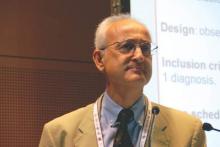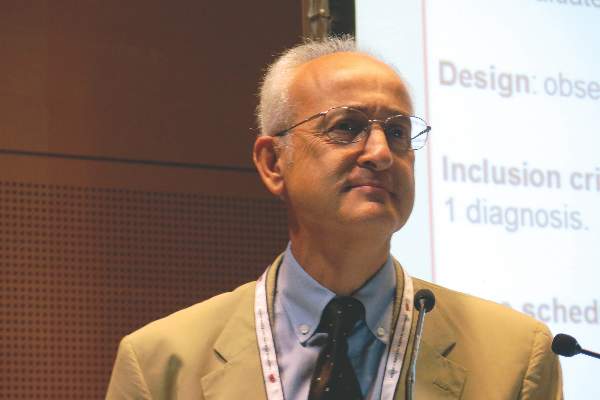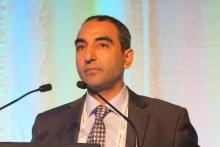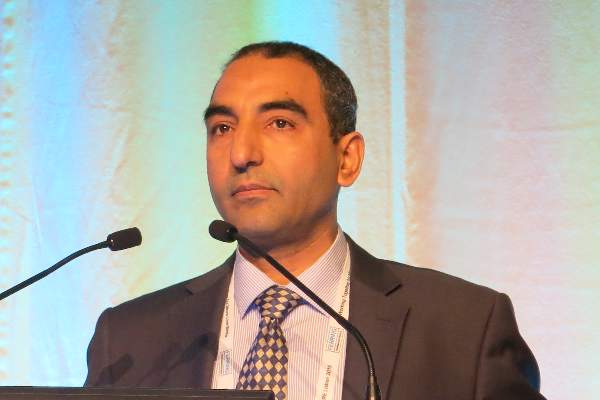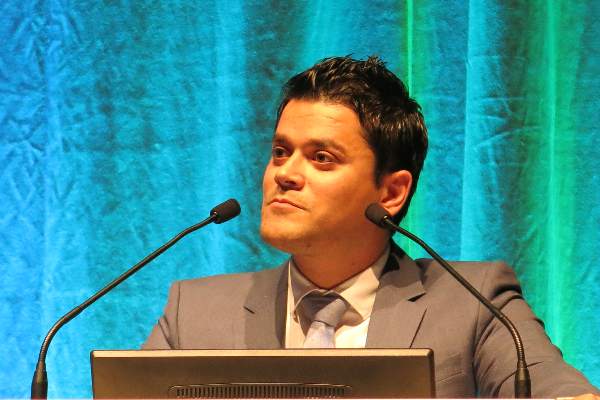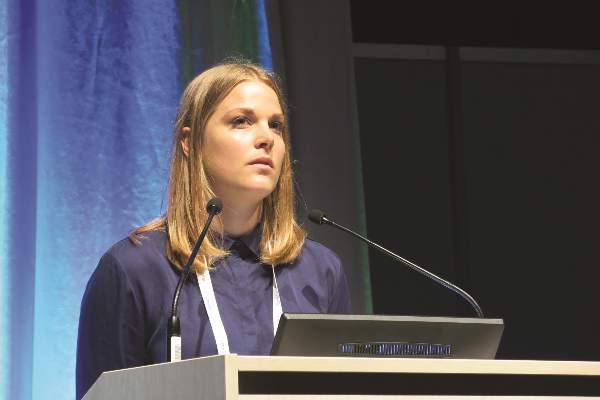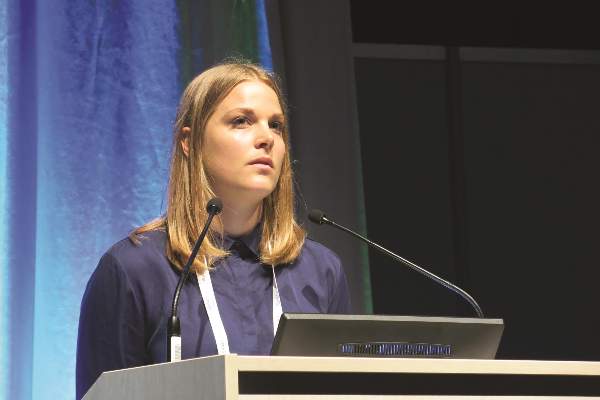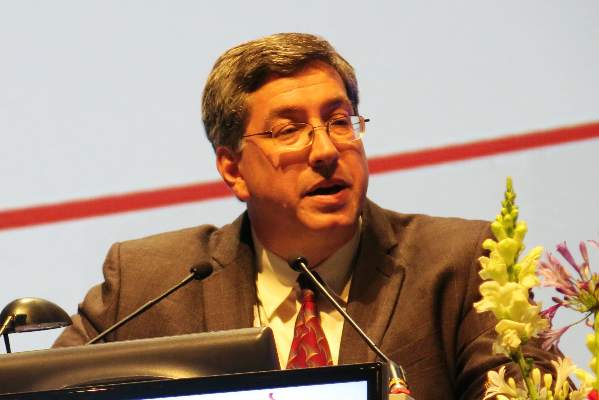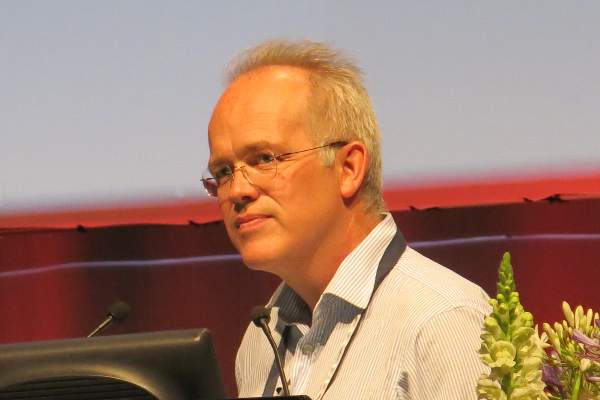User login
Surgical bleeding risk ‘remarkable’ with platelet disorders
VIENNA – Inherited platelet function disorders are associated with a significant bleeding risk during surgery, a retrospective, multicenter study shows.
“The frequency of excessive bleeding assessed by one of three criteria at surgery is pretty remarkable because we had rates ranging from 13% to about 19% depending on the assessment criteria,” Dr. Paolo Gresele said at the annual congress of the European Hematology Association.
Any excessive bleeding by any criteria took place in about 23% of patients.
Although conventionally considered rare, inherited platelet function disorders (IPFD) are more frequent than previously thought, and recent advances in their diagnosis have expanded the forms and number of reported patients.
Only a handful of case reports or small case series have evaluated the bleeding risk associated with surgery in patients with IPFD. As a result, the exact bleeding risk and most appropriate management options in IPFD are not known, Dr. Gresele of University of Perugia (Italy) said.
He reported on a retrospective study involving patients with IPFD enrolled at 42 centers from 16 countries. The median age of the 205 patients was 35 years, and 56% were women; 89 had Glanzmann thrombasthenia, 46 had primary secretion defect, 14 had combined alpha-delta granule deficiency, 11 had Hermansky-Pudlak syndrome, 9 had gray platelet syndrome, and 36 had other forms of IPFD.
Data were collected from 389 procedures, of which 54.5% were surgeries, 30% were dental procedures, and 15.5% were invasive procedures. The most frequent surgeries were otolaryngologic, abdominal, orthopedic, gynecologic, urologic, and dermatologic.
The frequency of excessive bleeding at surgery was about 19.7% by the Bleeding Academic Research Consortium (BARC) bleeding classification, 17% by subjective evaluation by the surgeon or patient, and 13% based on duration of bleeding at surgery of at least 6 or more hours, Dr. Gresele said.
The World Health Organization (WHO) bleeding scale before surgery was quite predictive of excessive bleeding at surgery, with patients at grade 3 and 4 having an odds ratio for excessive bleeding of 9.22 and 28, respectively, compared with patients at grade 0, he said.
Somewhat unexpectedly, the most serious bleeders based on a BARC of at least 2 or more at surgery were patients with Hermansky-Pudlak syndrome, Glanzmann thrombasthenia, and gray platelet syndrome. Those with primary secretion defect and combined alpha-delta granule deficiency had a relatively low risk of bleeding at surgery, he said.
The procedures associated with more excessive bleeding were urologic surgery, gynecologic surgery, and abdominal surgery.
Preparation for surgery was made in 82% of procedures and included prophylactic platelet transfusions in 38.5%, desmopressin (DDAVP) in about 19%, antifibrinolytic agents in about 12%, factor VIIa in less than 10%, and other interventions such as cryoprecipitate, fibrinogen, fresh frozen plasma, intravenous immunoglobulin, suture, and local hemostatic agent in less than 5%.
Generally all measures had a good ability to prevent excessive bleeding, bringing rates down to about 20% or less, Dr. Gresele said. The two exceptions were no prophylaxis and “other” interventions, where the bleeding rate reached a high of about 45% for the latter. In contrast, bleeding risk was significantly reduced when any prophylaxis (odds ratio, 0.38) or DDAVP (OR, 0.24) were used.
In 87 cases, however, emergency treatment for excessive bleeding was required, he said. Platelet transfusions were the most common treatment, given in roughly half of patients, followed by antifibrinolytic agents. The success rate was about 80% for all measures, except for “other” interventions, which had a success rate of about 65%.
“Treatment of excessive bleeding is made mostly with platelet transfusions or antifibrinolytic agents and is able to stop bleeding in many, but not all cases,” Dr. Gresele concluded.
On Twitter @pwendl
VIENNA – Inherited platelet function disorders are associated with a significant bleeding risk during surgery, a retrospective, multicenter study shows.
“The frequency of excessive bleeding assessed by one of three criteria at surgery is pretty remarkable because we had rates ranging from 13% to about 19% depending on the assessment criteria,” Dr. Paolo Gresele said at the annual congress of the European Hematology Association.
Any excessive bleeding by any criteria took place in about 23% of patients.
Although conventionally considered rare, inherited platelet function disorders (IPFD) are more frequent than previously thought, and recent advances in their diagnosis have expanded the forms and number of reported patients.
Only a handful of case reports or small case series have evaluated the bleeding risk associated with surgery in patients with IPFD. As a result, the exact bleeding risk and most appropriate management options in IPFD are not known, Dr. Gresele of University of Perugia (Italy) said.
He reported on a retrospective study involving patients with IPFD enrolled at 42 centers from 16 countries. The median age of the 205 patients was 35 years, and 56% were women; 89 had Glanzmann thrombasthenia, 46 had primary secretion defect, 14 had combined alpha-delta granule deficiency, 11 had Hermansky-Pudlak syndrome, 9 had gray platelet syndrome, and 36 had other forms of IPFD.
Data were collected from 389 procedures, of which 54.5% were surgeries, 30% were dental procedures, and 15.5% were invasive procedures. The most frequent surgeries were otolaryngologic, abdominal, orthopedic, gynecologic, urologic, and dermatologic.
The frequency of excessive bleeding at surgery was about 19.7% by the Bleeding Academic Research Consortium (BARC) bleeding classification, 17% by subjective evaluation by the surgeon or patient, and 13% based on duration of bleeding at surgery of at least 6 or more hours, Dr. Gresele said.
The World Health Organization (WHO) bleeding scale before surgery was quite predictive of excessive bleeding at surgery, with patients at grade 3 and 4 having an odds ratio for excessive bleeding of 9.22 and 28, respectively, compared with patients at grade 0, he said.
Somewhat unexpectedly, the most serious bleeders based on a BARC of at least 2 or more at surgery were patients with Hermansky-Pudlak syndrome, Glanzmann thrombasthenia, and gray platelet syndrome. Those with primary secretion defect and combined alpha-delta granule deficiency had a relatively low risk of bleeding at surgery, he said.
The procedures associated with more excessive bleeding were urologic surgery, gynecologic surgery, and abdominal surgery.
Preparation for surgery was made in 82% of procedures and included prophylactic platelet transfusions in 38.5%, desmopressin (DDAVP) in about 19%, antifibrinolytic agents in about 12%, factor VIIa in less than 10%, and other interventions such as cryoprecipitate, fibrinogen, fresh frozen plasma, intravenous immunoglobulin, suture, and local hemostatic agent in less than 5%.
Generally all measures had a good ability to prevent excessive bleeding, bringing rates down to about 20% or less, Dr. Gresele said. The two exceptions were no prophylaxis and “other” interventions, where the bleeding rate reached a high of about 45% for the latter. In contrast, bleeding risk was significantly reduced when any prophylaxis (odds ratio, 0.38) or DDAVP (OR, 0.24) were used.
In 87 cases, however, emergency treatment for excessive bleeding was required, he said. Platelet transfusions were the most common treatment, given in roughly half of patients, followed by antifibrinolytic agents. The success rate was about 80% for all measures, except for “other” interventions, which had a success rate of about 65%.
“Treatment of excessive bleeding is made mostly with platelet transfusions or antifibrinolytic agents and is able to stop bleeding in many, but not all cases,” Dr. Gresele concluded.
On Twitter @pwendl
VIENNA – Inherited platelet function disorders are associated with a significant bleeding risk during surgery, a retrospective, multicenter study shows.
“The frequency of excessive bleeding assessed by one of three criteria at surgery is pretty remarkable because we had rates ranging from 13% to about 19% depending on the assessment criteria,” Dr. Paolo Gresele said at the annual congress of the European Hematology Association.
Any excessive bleeding by any criteria took place in about 23% of patients.
Although conventionally considered rare, inherited platelet function disorders (IPFD) are more frequent than previously thought, and recent advances in their diagnosis have expanded the forms and number of reported patients.
Only a handful of case reports or small case series have evaluated the bleeding risk associated with surgery in patients with IPFD. As a result, the exact bleeding risk and most appropriate management options in IPFD are not known, Dr. Gresele of University of Perugia (Italy) said.
He reported on a retrospective study involving patients with IPFD enrolled at 42 centers from 16 countries. The median age of the 205 patients was 35 years, and 56% were women; 89 had Glanzmann thrombasthenia, 46 had primary secretion defect, 14 had combined alpha-delta granule deficiency, 11 had Hermansky-Pudlak syndrome, 9 had gray platelet syndrome, and 36 had other forms of IPFD.
Data were collected from 389 procedures, of which 54.5% were surgeries, 30% were dental procedures, and 15.5% were invasive procedures. The most frequent surgeries were otolaryngologic, abdominal, orthopedic, gynecologic, urologic, and dermatologic.
The frequency of excessive bleeding at surgery was about 19.7% by the Bleeding Academic Research Consortium (BARC) bleeding classification, 17% by subjective evaluation by the surgeon or patient, and 13% based on duration of bleeding at surgery of at least 6 or more hours, Dr. Gresele said.
The World Health Organization (WHO) bleeding scale before surgery was quite predictive of excessive bleeding at surgery, with patients at grade 3 and 4 having an odds ratio for excessive bleeding of 9.22 and 28, respectively, compared with patients at grade 0, he said.
Somewhat unexpectedly, the most serious bleeders based on a BARC of at least 2 or more at surgery were patients with Hermansky-Pudlak syndrome, Glanzmann thrombasthenia, and gray platelet syndrome. Those with primary secretion defect and combined alpha-delta granule deficiency had a relatively low risk of bleeding at surgery, he said.
The procedures associated with more excessive bleeding were urologic surgery, gynecologic surgery, and abdominal surgery.
Preparation for surgery was made in 82% of procedures and included prophylactic platelet transfusions in 38.5%, desmopressin (DDAVP) in about 19%, antifibrinolytic agents in about 12%, factor VIIa in less than 10%, and other interventions such as cryoprecipitate, fibrinogen, fresh frozen plasma, intravenous immunoglobulin, suture, and local hemostatic agent in less than 5%.
Generally all measures had a good ability to prevent excessive bleeding, bringing rates down to about 20% or less, Dr. Gresele said. The two exceptions were no prophylaxis and “other” interventions, where the bleeding rate reached a high of about 45% for the latter. In contrast, bleeding risk was significantly reduced when any prophylaxis (odds ratio, 0.38) or DDAVP (OR, 0.24) were used.
In 87 cases, however, emergency treatment for excessive bleeding was required, he said. Platelet transfusions were the most common treatment, given in roughly half of patients, followed by antifibrinolytic agents. The success rate was about 80% for all measures, except for “other” interventions, which had a success rate of about 65%.
“Treatment of excessive bleeding is made mostly with platelet transfusions or antifibrinolytic agents and is able to stop bleeding in many, but not all cases,” Dr. Gresele concluded.
On Twitter @pwendl
AT THE EHA CONGRESS
Key clinical point: Inherited platelet function disorders are associated with a significant surgical bleeding risk.
Major finding: The frequency of excessive bleeding ranged from about 13% to about 19%.
Data source: Retrospective, multicenter study in 205 patients with inherited platelet function disorders and 389 procedures.
Disclosures: Dr. Gesele reported no financial disclosures.
Advanced age no barrier to continuous myeloma regimen
VIENNA – Elderly patients over age 75 with newly diagnosed multiple myeloma derive the same survival benefits from continuous lenalidomide and low-dose dexamethasone as those under 75, according to a new analysis of the pivotal phase III FIRST trial.
In those older than 75 years, continuous lenalidomide (Revlimid) and low-dose dexamethasone demonstrated a 14-month overall survival advantage (hazard ratio, 0.72; 95% confidence interval, 0.54-0.96) and 20% reduction in the risk of progression or death (HR, 0.80; 95% CI, 0.62-1.03) compared with melphalan (Alkeran) plus prednisone and thalidomide (MPT).
“With dose adjustment and monitoring, this continuous len-dex arm was effective and safe, even in very elderly and frail patients. This [trial] establishes this regimen as a global standard of care for transplant-ineligible patients,” Dr. Thierry Facon said at the annual congress of the European Hematology Association.
FIRST is the largest randomized trial in this setting and allocated 1,623 patients to lenalidomide plus low-dose dexamethasone in 28-day cycles until disease progression (Rd continuous) or 18 cycles of the same regimen for 72 weeks (Rd 18) or 12 cycles of MPT for 72 weeks.
In an interim analysis published in the New England Journal of Medicine (2014 [doi:10.1056/nejmoa1402551]) treatment with Rd continuous reduced the risk of progression or death by 28% and the risk of death by 22%, compared with MPT, a standard therapy for transplant-ineligible patients.
The new analysis is important because it is the first to examine the impact of age on the efficacy and safety of Rd continuous. Multiple myeloma is a disease of the elderly, with roughly one-third of patients diagnosed at more than 75 years, according to Dr. Facon of University Hospital Huriez, Lille, France.
Overall, 567 patients were older than 75 years (median 79 years) and 1,056 were 75 years or less (median 70 years). Starting doses for the very elderly group were reduced from 40 mg to 20 mg for dexamethasone; from 200 mg to 100 mg for thalidomide; and from 0.25 mg/kg to 0.20 mg/kg for melphalan. In patients with low blood count or impaired renal function, melphalan dose was reduced from 0.125 kg/mg to 0.10 mg/kg. All patients received thromboprophylaxis.
Median progression-free survival (PFS) in the 75-year and younger group was 28.1 months with Rd continuous, 21.6 months with Rd 18, and 22.4 months with MPT (Rd continuous vs. MPT: HR, 0.64; 95% CI, 0.53-0.77). The 4-year PFS rates were 37%, 15%, and 13%, Dr. Facon said.
In the very elderly group, median PFS reached 20.3 months, 19.4 months, and 19.8 months (HR, 0.80, also noted above), with 4-year PFS rates of 26%, 10%, and 11%.
“This is something quite important, illustrating the benefit of continuous therapy in terms of PFS,” he said.
Of note, median PFS in the interim analysis was similar at 25.5 months for Rd continuous, 20.7 months for Rd 18, and 21.2 months for MPT.
In the new analysis, overall survival in the 75 years and younger group was 60.9 months with Rd continuous, 60.6 months with Rd 18, and 55.3 months with MPT (Rd continuous vs. MPT: HR, 0.76, 95% CI, 0.60-0.96). The 4-year overall survival (OS) rates were 64%, 61%, and 57%.
Among the very elderly, median OS was 52.3 months with Rd continuous, 45.7 with Rd 18, and 37.8 months with MPT (HR, 0.72, also noted above), with 4-year OS rates of 52%, 48%, and 39%.
Duration of response was improved with Rd continuous treatment, irrespective of age, Dr. Facon said. The median duration for Rd continuous was 37 months in those aged 75 years and younger and 27 months in the very elderly, compared with 21-22 months for all other treatments.
Dose reductions due to adverse events were less common in those aged 75 years and under for Rd continuous than for MPT (37% vs. 52%), as were treatment discontinuations (21% vs. 26%). More very elderly patients required dose reductions for Rd continuous than MPT (44% vs. 36%), but fewer went on to discontinue Rd continuous (26% vs 29%), he said.
Rates of grade 3/4 neutropenia, the most common hematologic adverse event occurring in at least 5% of patients, were lower with Rd continuous and Rd 18 than with MPT in those aged 75 years and younger (28% vs. 25% vs. 47%) and in the very elderly (29% vs. 29% vs. 40%).
There is possibly a difference in cardiac events, which moved from 6% with MPT to 12% with Rd continuous in patients aged 75 years and younger and from 13% with MPT to 12% with Rd continuous in the very elderly, “but otherwise the results were quite similar, especially for neurologic toxicity and thromboembolic events,” he said.
During a discussion of the results, Dr. Facon acknowledged that the survival difference between the Rd continuous and Rd 18 groups was marginal and said additional insights will come from the final survival analysis as well as the recently published quality of life analyses.
When asked whether he would prefer Rd to VMP (bortezomib, melphalan, and prednisone), Dr. Facon said both regimens are standards of care in transplant-ineligible myeloma patients and cautioned against making cross-trial comparisons between FIRST and the older VISTA study of VMP.
“I would just say that these two regimens are effective and safe regimens, and it is also a discussion with your patients,” he said. “You may say that’s an easy answer, but I think it’s a fair answer.”
In February, the Food and Drug Administration expanded the indication for lenalidomide in combination with dexamethasone to include patients with newly diagnosed multiple myeloma.
FIRST was funded by Intergroupe Francophone du Myélome and Celgene. Dr. Facon reported consulting for and honoraria from Celgene.
On Twitter @pwendl
VIENNA – Elderly patients over age 75 with newly diagnosed multiple myeloma derive the same survival benefits from continuous lenalidomide and low-dose dexamethasone as those under 75, according to a new analysis of the pivotal phase III FIRST trial.
In those older than 75 years, continuous lenalidomide (Revlimid) and low-dose dexamethasone demonstrated a 14-month overall survival advantage (hazard ratio, 0.72; 95% confidence interval, 0.54-0.96) and 20% reduction in the risk of progression or death (HR, 0.80; 95% CI, 0.62-1.03) compared with melphalan (Alkeran) plus prednisone and thalidomide (MPT).
“With dose adjustment and monitoring, this continuous len-dex arm was effective and safe, even in very elderly and frail patients. This [trial] establishes this regimen as a global standard of care for transplant-ineligible patients,” Dr. Thierry Facon said at the annual congress of the European Hematology Association.
FIRST is the largest randomized trial in this setting and allocated 1,623 patients to lenalidomide plus low-dose dexamethasone in 28-day cycles until disease progression (Rd continuous) or 18 cycles of the same regimen for 72 weeks (Rd 18) or 12 cycles of MPT for 72 weeks.
In an interim analysis published in the New England Journal of Medicine (2014 [doi:10.1056/nejmoa1402551]) treatment with Rd continuous reduced the risk of progression or death by 28% and the risk of death by 22%, compared with MPT, a standard therapy for transplant-ineligible patients.
The new analysis is important because it is the first to examine the impact of age on the efficacy and safety of Rd continuous. Multiple myeloma is a disease of the elderly, with roughly one-third of patients diagnosed at more than 75 years, according to Dr. Facon of University Hospital Huriez, Lille, France.
Overall, 567 patients were older than 75 years (median 79 years) and 1,056 were 75 years or less (median 70 years). Starting doses for the very elderly group were reduced from 40 mg to 20 mg for dexamethasone; from 200 mg to 100 mg for thalidomide; and from 0.25 mg/kg to 0.20 mg/kg for melphalan. In patients with low blood count or impaired renal function, melphalan dose was reduced from 0.125 kg/mg to 0.10 mg/kg. All patients received thromboprophylaxis.
Median progression-free survival (PFS) in the 75-year and younger group was 28.1 months with Rd continuous, 21.6 months with Rd 18, and 22.4 months with MPT (Rd continuous vs. MPT: HR, 0.64; 95% CI, 0.53-0.77). The 4-year PFS rates were 37%, 15%, and 13%, Dr. Facon said.
In the very elderly group, median PFS reached 20.3 months, 19.4 months, and 19.8 months (HR, 0.80, also noted above), with 4-year PFS rates of 26%, 10%, and 11%.
“This is something quite important, illustrating the benefit of continuous therapy in terms of PFS,” he said.
Of note, median PFS in the interim analysis was similar at 25.5 months for Rd continuous, 20.7 months for Rd 18, and 21.2 months for MPT.
In the new analysis, overall survival in the 75 years and younger group was 60.9 months with Rd continuous, 60.6 months with Rd 18, and 55.3 months with MPT (Rd continuous vs. MPT: HR, 0.76, 95% CI, 0.60-0.96). The 4-year overall survival (OS) rates were 64%, 61%, and 57%.
Among the very elderly, median OS was 52.3 months with Rd continuous, 45.7 with Rd 18, and 37.8 months with MPT (HR, 0.72, also noted above), with 4-year OS rates of 52%, 48%, and 39%.
Duration of response was improved with Rd continuous treatment, irrespective of age, Dr. Facon said. The median duration for Rd continuous was 37 months in those aged 75 years and younger and 27 months in the very elderly, compared with 21-22 months for all other treatments.
Dose reductions due to adverse events were less common in those aged 75 years and under for Rd continuous than for MPT (37% vs. 52%), as were treatment discontinuations (21% vs. 26%). More very elderly patients required dose reductions for Rd continuous than MPT (44% vs. 36%), but fewer went on to discontinue Rd continuous (26% vs 29%), he said.
Rates of grade 3/4 neutropenia, the most common hematologic adverse event occurring in at least 5% of patients, were lower with Rd continuous and Rd 18 than with MPT in those aged 75 years and younger (28% vs. 25% vs. 47%) and in the very elderly (29% vs. 29% vs. 40%).
There is possibly a difference in cardiac events, which moved from 6% with MPT to 12% with Rd continuous in patients aged 75 years and younger and from 13% with MPT to 12% with Rd continuous in the very elderly, “but otherwise the results were quite similar, especially for neurologic toxicity and thromboembolic events,” he said.
During a discussion of the results, Dr. Facon acknowledged that the survival difference between the Rd continuous and Rd 18 groups was marginal and said additional insights will come from the final survival analysis as well as the recently published quality of life analyses.
When asked whether he would prefer Rd to VMP (bortezomib, melphalan, and prednisone), Dr. Facon said both regimens are standards of care in transplant-ineligible myeloma patients and cautioned against making cross-trial comparisons between FIRST and the older VISTA study of VMP.
“I would just say that these two regimens are effective and safe regimens, and it is also a discussion with your patients,” he said. “You may say that’s an easy answer, but I think it’s a fair answer.”
In February, the Food and Drug Administration expanded the indication for lenalidomide in combination with dexamethasone to include patients with newly diagnosed multiple myeloma.
FIRST was funded by Intergroupe Francophone du Myélome and Celgene. Dr. Facon reported consulting for and honoraria from Celgene.
On Twitter @pwendl
VIENNA – Elderly patients over age 75 with newly diagnosed multiple myeloma derive the same survival benefits from continuous lenalidomide and low-dose dexamethasone as those under 75, according to a new analysis of the pivotal phase III FIRST trial.
In those older than 75 years, continuous lenalidomide (Revlimid) and low-dose dexamethasone demonstrated a 14-month overall survival advantage (hazard ratio, 0.72; 95% confidence interval, 0.54-0.96) and 20% reduction in the risk of progression or death (HR, 0.80; 95% CI, 0.62-1.03) compared with melphalan (Alkeran) plus prednisone and thalidomide (MPT).
“With dose adjustment and monitoring, this continuous len-dex arm was effective and safe, even in very elderly and frail patients. This [trial] establishes this regimen as a global standard of care for transplant-ineligible patients,” Dr. Thierry Facon said at the annual congress of the European Hematology Association.
FIRST is the largest randomized trial in this setting and allocated 1,623 patients to lenalidomide plus low-dose dexamethasone in 28-day cycles until disease progression (Rd continuous) or 18 cycles of the same regimen for 72 weeks (Rd 18) or 12 cycles of MPT for 72 weeks.
In an interim analysis published in the New England Journal of Medicine (2014 [doi:10.1056/nejmoa1402551]) treatment with Rd continuous reduced the risk of progression or death by 28% and the risk of death by 22%, compared with MPT, a standard therapy for transplant-ineligible patients.
The new analysis is important because it is the first to examine the impact of age on the efficacy and safety of Rd continuous. Multiple myeloma is a disease of the elderly, with roughly one-third of patients diagnosed at more than 75 years, according to Dr. Facon of University Hospital Huriez, Lille, France.
Overall, 567 patients were older than 75 years (median 79 years) and 1,056 were 75 years or less (median 70 years). Starting doses for the very elderly group were reduced from 40 mg to 20 mg for dexamethasone; from 200 mg to 100 mg for thalidomide; and from 0.25 mg/kg to 0.20 mg/kg for melphalan. In patients with low blood count or impaired renal function, melphalan dose was reduced from 0.125 kg/mg to 0.10 mg/kg. All patients received thromboprophylaxis.
Median progression-free survival (PFS) in the 75-year and younger group was 28.1 months with Rd continuous, 21.6 months with Rd 18, and 22.4 months with MPT (Rd continuous vs. MPT: HR, 0.64; 95% CI, 0.53-0.77). The 4-year PFS rates were 37%, 15%, and 13%, Dr. Facon said.
In the very elderly group, median PFS reached 20.3 months, 19.4 months, and 19.8 months (HR, 0.80, also noted above), with 4-year PFS rates of 26%, 10%, and 11%.
“This is something quite important, illustrating the benefit of continuous therapy in terms of PFS,” he said.
Of note, median PFS in the interim analysis was similar at 25.5 months for Rd continuous, 20.7 months for Rd 18, and 21.2 months for MPT.
In the new analysis, overall survival in the 75 years and younger group was 60.9 months with Rd continuous, 60.6 months with Rd 18, and 55.3 months with MPT (Rd continuous vs. MPT: HR, 0.76, 95% CI, 0.60-0.96). The 4-year overall survival (OS) rates were 64%, 61%, and 57%.
Among the very elderly, median OS was 52.3 months with Rd continuous, 45.7 with Rd 18, and 37.8 months with MPT (HR, 0.72, also noted above), with 4-year OS rates of 52%, 48%, and 39%.
Duration of response was improved with Rd continuous treatment, irrespective of age, Dr. Facon said. The median duration for Rd continuous was 37 months in those aged 75 years and younger and 27 months in the very elderly, compared with 21-22 months for all other treatments.
Dose reductions due to adverse events were less common in those aged 75 years and under for Rd continuous than for MPT (37% vs. 52%), as were treatment discontinuations (21% vs. 26%). More very elderly patients required dose reductions for Rd continuous than MPT (44% vs. 36%), but fewer went on to discontinue Rd continuous (26% vs 29%), he said.
Rates of grade 3/4 neutropenia, the most common hematologic adverse event occurring in at least 5% of patients, were lower with Rd continuous and Rd 18 than with MPT in those aged 75 years and younger (28% vs. 25% vs. 47%) and in the very elderly (29% vs. 29% vs. 40%).
There is possibly a difference in cardiac events, which moved from 6% with MPT to 12% with Rd continuous in patients aged 75 years and younger and from 13% with MPT to 12% with Rd continuous in the very elderly, “but otherwise the results were quite similar, especially for neurologic toxicity and thromboembolic events,” he said.
During a discussion of the results, Dr. Facon acknowledged that the survival difference between the Rd continuous and Rd 18 groups was marginal and said additional insights will come from the final survival analysis as well as the recently published quality of life analyses.
When asked whether he would prefer Rd to VMP (bortezomib, melphalan, and prednisone), Dr. Facon said both regimens are standards of care in transplant-ineligible myeloma patients and cautioned against making cross-trial comparisons between FIRST and the older VISTA study of VMP.
“I would just say that these two regimens are effective and safe regimens, and it is also a discussion with your patients,” he said. “You may say that’s an easy answer, but I think it’s a fair answer.”
In February, the Food and Drug Administration expanded the indication for lenalidomide in combination with dexamethasone to include patients with newly diagnosed multiple myeloma.
FIRST was funded by Intergroupe Francophone du Myélome and Celgene. Dr. Facon reported consulting for and honoraria from Celgene.
On Twitter @pwendl
AT THE EHA CONGRESS
Key clinical point: Patients over age 75 draw the same survival benefit with continuous lenalidomide plus low-dose dexamethasone over MPT as their younger counterparts.
Major finding: Continuous lenalidomide plus low-dose dexamethasone provided a 14-month overall survival advantage and 20% reduction in the risk of progression or death, compared with MPT in patients over age 75.
Data source: Phase III trial in 1,623 transplant-ineligible patients with newly diagnosed multiple myeloma.
Disclosures: FIRST was funded by Intergroupe Francophone du Myélome and Celgene. Dr. Facon reported consulting for and honoraria from Celgene.
Transdermal testosterone tanks in poor ovarian responders
LISBON – Pretreatment with transdermal testosterone failed to improve outcomes in women with poor ovarian response who were undergoing intra-cytoplasmic sperm injection in a randomized clinical study.
The primary endpoint, number of cumulus-oocyte complexes (COCs) retrieved, was not significantly different with testosterone gel 10 mg applied to the thigh for 21 days before ovarian stimulation versus no pretreatment (median, 3.5 vs. 3.0; P = .91).
Further, no differences were observed in fertilization rates (66.7% vs. 66.7%; P = .97) or live birth rates per intention-to-treat analysis (7.7% vs. 8.3%; 95% confidence interval, –19.0 to +16.9).
“An improvement in {in vitro fertilization] outcome cannot be excluded using a larger dose of testosterone more than 10 mg or a pretreatment period longer than 21 days,” study author Dr. Julia Bosdou said at the annual meeting of the European Society of Human Reproduction and Embryology.
Because of sample size restrictions, no conclusions can be drawn regarding the probability of live birth, she added.
The study was designed to detect a difference of 1.5 COCs retrieved with a sample size of 42 patients. In all, 50 women who fulfilled the Bologna criteria for poor ovarian response were allocated to the testosterone group (n = 26) or control group (n = 24). All patients underwent a long follicular gonadotropin-releasing hormone agonist (GnRHa) protocol. Recombinant follicle-stimulating hormone (FSH) 300 IU daily was started on day 22 following GnRHa initiation.
The testosterone dose was based on published data showing a beneficial effect with a 21-day duration, said Dr. Bosdou of the Aristotle University of Thessaloniki (Greece).
Androgens have been suggested to play a critical role in early follicular development by enhancing ovarian sensitivity to FSH. A recent meta-analysis by the investigators of the current study also showed that pretreatment with transdermal testosterone increased clinical pregnancy and live birth rates in poor responders, but it was based on only two randomized trials (Hum. Reprod. Update 2012;18:127-45), she observed.
As expected, testosterone levels in the current study were significantly higher in the testosterone group than the control group on day 22 (median, 114 ng/dL vs. 20 ng/dL; P < .001). Duration of FSH stimulation was comparable between groups (12.5 days vs. 12 days; P = .48), Dr. Bosdou said.
Endometrial thickness on the day of human chorionic gonadotropin administration was significantly greater with testosterone pretreatment (median, 10.7 mm vs. 9 mm; P = .03).
No adverse events were reported in either group, she said.
The study was partially funded by a scholarship award to Dr. Bosdou from the Academy of Athens. Dr. Bosdou reported having no conflicts of interest.
On Twitter @pwendl
LISBON – Pretreatment with transdermal testosterone failed to improve outcomes in women with poor ovarian response who were undergoing intra-cytoplasmic sperm injection in a randomized clinical study.
The primary endpoint, number of cumulus-oocyte complexes (COCs) retrieved, was not significantly different with testosterone gel 10 mg applied to the thigh for 21 days before ovarian stimulation versus no pretreatment (median, 3.5 vs. 3.0; P = .91).
Further, no differences were observed in fertilization rates (66.7% vs. 66.7%; P = .97) or live birth rates per intention-to-treat analysis (7.7% vs. 8.3%; 95% confidence interval, –19.0 to +16.9).
“An improvement in {in vitro fertilization] outcome cannot be excluded using a larger dose of testosterone more than 10 mg or a pretreatment period longer than 21 days,” study author Dr. Julia Bosdou said at the annual meeting of the European Society of Human Reproduction and Embryology.
Because of sample size restrictions, no conclusions can be drawn regarding the probability of live birth, she added.
The study was designed to detect a difference of 1.5 COCs retrieved with a sample size of 42 patients. In all, 50 women who fulfilled the Bologna criteria for poor ovarian response were allocated to the testosterone group (n = 26) or control group (n = 24). All patients underwent a long follicular gonadotropin-releasing hormone agonist (GnRHa) protocol. Recombinant follicle-stimulating hormone (FSH) 300 IU daily was started on day 22 following GnRHa initiation.
The testosterone dose was based on published data showing a beneficial effect with a 21-day duration, said Dr. Bosdou of the Aristotle University of Thessaloniki (Greece).
Androgens have been suggested to play a critical role in early follicular development by enhancing ovarian sensitivity to FSH. A recent meta-analysis by the investigators of the current study also showed that pretreatment with transdermal testosterone increased clinical pregnancy and live birth rates in poor responders, but it was based on only two randomized trials (Hum. Reprod. Update 2012;18:127-45), she observed.
As expected, testosterone levels in the current study were significantly higher in the testosterone group than the control group on day 22 (median, 114 ng/dL vs. 20 ng/dL; P < .001). Duration of FSH stimulation was comparable between groups (12.5 days vs. 12 days; P = .48), Dr. Bosdou said.
Endometrial thickness on the day of human chorionic gonadotropin administration was significantly greater with testosterone pretreatment (median, 10.7 mm vs. 9 mm; P = .03).
No adverse events were reported in either group, she said.
The study was partially funded by a scholarship award to Dr. Bosdou from the Academy of Athens. Dr. Bosdou reported having no conflicts of interest.
On Twitter @pwendl
LISBON – Pretreatment with transdermal testosterone failed to improve outcomes in women with poor ovarian response who were undergoing intra-cytoplasmic sperm injection in a randomized clinical study.
The primary endpoint, number of cumulus-oocyte complexes (COCs) retrieved, was not significantly different with testosterone gel 10 mg applied to the thigh for 21 days before ovarian stimulation versus no pretreatment (median, 3.5 vs. 3.0; P = .91).
Further, no differences were observed in fertilization rates (66.7% vs. 66.7%; P = .97) or live birth rates per intention-to-treat analysis (7.7% vs. 8.3%; 95% confidence interval, –19.0 to +16.9).
“An improvement in {in vitro fertilization] outcome cannot be excluded using a larger dose of testosterone more than 10 mg or a pretreatment period longer than 21 days,” study author Dr. Julia Bosdou said at the annual meeting of the European Society of Human Reproduction and Embryology.
Because of sample size restrictions, no conclusions can be drawn regarding the probability of live birth, she added.
The study was designed to detect a difference of 1.5 COCs retrieved with a sample size of 42 patients. In all, 50 women who fulfilled the Bologna criteria for poor ovarian response were allocated to the testosterone group (n = 26) or control group (n = 24). All patients underwent a long follicular gonadotropin-releasing hormone agonist (GnRHa) protocol. Recombinant follicle-stimulating hormone (FSH) 300 IU daily was started on day 22 following GnRHa initiation.
The testosterone dose was based on published data showing a beneficial effect with a 21-day duration, said Dr. Bosdou of the Aristotle University of Thessaloniki (Greece).
Androgens have been suggested to play a critical role in early follicular development by enhancing ovarian sensitivity to FSH. A recent meta-analysis by the investigators of the current study also showed that pretreatment with transdermal testosterone increased clinical pregnancy and live birth rates in poor responders, but it was based on only two randomized trials (Hum. Reprod. Update 2012;18:127-45), she observed.
As expected, testosterone levels in the current study were significantly higher in the testosterone group than the control group on day 22 (median, 114 ng/dL vs. 20 ng/dL; P < .001). Duration of FSH stimulation was comparable between groups (12.5 days vs. 12 days; P = .48), Dr. Bosdou said.
Endometrial thickness on the day of human chorionic gonadotropin administration was significantly greater with testosterone pretreatment (median, 10.7 mm vs. 9 mm; P = .03).
No adverse events were reported in either group, she said.
The study was partially funded by a scholarship award to Dr. Bosdou from the Academy of Athens. Dr. Bosdou reported having no conflicts of interest.
On Twitter @pwendl
AT ESHRE 2015
Key clinical point: Pretreatment with transdermal testosterone did not improve the number of cumulus-oocyte complexes retrieved in poor ovarian responders.
Major finding: The median number of COCs retrieved was 3.5 in the testosterone group vs. 3 in the control group (P = .91).
Data source: A randomized, placebo-controlled trial in 50 poor ovarian responders.
Disclosures: The study was partially funded by a scholarship award to Dr. Bosdou from the Academy of Athens. Dr. Bosdou reported having no conflicts of interest.
Letrozole bests clomiphene again in infertile women with PCOS
LISBON – The aromatase inhibitor letrozole was associated with roughly a 42% increase in the pregnancy rate, compared with clomiphene citrate in infertile women with polycystic ovary syndrome in a double-blind, randomized study.
In an intention-to-treat analysis, the pregnancy rate was 61.2% with letrozole (Femara) versus 43% with clomiphene (P = .022). There also was a trend toward more live births with letrozole (48.8% vs. 35.4%; P = .089).
The per-protocol results were similar for pregnancy (61% vs. 43.2%; P = .029) and live births (48.1% vs. 35.1%; P = .108).
“We now have convincing evidence that letrozole is better than clomiphene and we should seriously consider moving on to letrozole,” principle investigator Dr. Saad Amer said at the annual meeting of the European Society of Human Reproduction and Embryology.
The results are consistent with the most recent Cochrane meta-analysis, which called for further research comparing letrozole with clomiphene as a primary ovulation induction agent in polycystic ovary syndrome (PCOS) because of low-quality evidence (Cochrane Database Syst. Rev. 2014 Feb. 24;2:CD010287).
A recent robust U.S. study (N. Engl. J. Med. 2014;371:119-29) showed higher live-birth and ovulation rates with letrozole vs. clomiphene in women with PCOS, but it included a markedly obese population with a mean body mass index (BMI) of 35 kg/m2 and thus does not reflect clinical practice worldwide, Dr. Amer said.
The current results are more generalizable, especially in Europe, because the patients fulfilled the widely accepted Rotterdam diagnostic criteria for PCOS and had a median BMI of 27.7 kg/m2 in the clomiphene group and 27.5 kg/m2 in the letrozole group, said Dr. Amer of the University of Nottingham in Derby, England.
The phase IV study evenly randomized 159 anovulatory women, aged 18-39 years, with a diagnosis of PCOS to one tablet of letrozole 2.5 mg or clomiphene 50 mg daily for 5 days, continuing until pregnancy or up to 6 cycles. If there was no response in the first cycle, the dose was increased to two tablets. If there was still no response, the patient was crossed over to the other treatment arm after a 6-week washout. Cycles were initially monitored with ultrasound follicle tracking, then mid-luteal serum progesterone measurements.
Among the 159 women in the intention-to-treat analysis, four conceived before treatment and four dropped out. The remaining 151 women included 77 given letrozole and 74 given clomiphene.
For the 60 women who crossed over, there was no significant difference in pregnancy and live birth rates between groups in either the intention-to-treat or per-protocol analyses.
Notably, however, 70.1% of women who started treatment with letrozole followed by clomiphene became pregnant vs. only 59.5% when the treatment strategy was reversed, while 56.2% started on letrozole and 49.4% started on clomiphene went on to a live birth.
“This tells us that if you take clomiphene first and then follow it with letrozole, you’re achieving almost the same result as just taking letrozole from the beginning,” Dr. Amer said.
The improved pregnancy rates, however, cannot be attributed to the effect of the endometrial factor, he said. Surprisingly, endometrial thickness was significantly greater in the clomiphene group than in the letrozole group (median, 9.0 mm vs. 8.4 mm; P = .002). Mono-follicular ovulation (83% vs. 85%) and multiple pregnancy (twins 0% vs. 6%) rates were similar.
No significant differences were observed between the clomiphene and letrozole groups in miscarriages (6 events vs. 9 events), ectopic pregnancies (0 vs. 1), or preterm births (2 vs. 4).
“Further research is required to investigate the mechanisms of increased pregnancy rates,” Dr. Amer said.
Serious adverse events included one hemorrhagic cyst in each group and a cholecystitis in the clomiphene group.
There was one fetal anomaly – a dilated left kidney – in the clomiphene group and none in the letrozole group, he said.
During a discussion of the results, reproductive medicine specialist Dr. Roy Homburg of Homerton University Hospital, London, said that it’s time for letrozole to recognized as the superior choice.
“Every study that has been done on the subject, every randomized controlled trial, every meta-analysis, every Cochrane database has shown exactly what you have shown – the superiority of letrozole over clomiphene,” Dr. Homburg said. “All this in addition to the fact that there are many more fetal abnormalities, congenital abnormalities with clomiphene rather than letrozole. I think it’s about time people start believing this and make sure letrozole is on-label rather than off-label.”
Dr. Amer agreed. “It’s now time for clomiphene to retire,” he said, receiving a round of applause from the audience.
The study was sponsored by Derby Hospitals NHS Foundation Trust. Dr. Amer reported having no financial disclosures.
On Twitter @pwendl
LISBON – The aromatase inhibitor letrozole was associated with roughly a 42% increase in the pregnancy rate, compared with clomiphene citrate in infertile women with polycystic ovary syndrome in a double-blind, randomized study.
In an intention-to-treat analysis, the pregnancy rate was 61.2% with letrozole (Femara) versus 43% with clomiphene (P = .022). There also was a trend toward more live births with letrozole (48.8% vs. 35.4%; P = .089).
The per-protocol results were similar for pregnancy (61% vs. 43.2%; P = .029) and live births (48.1% vs. 35.1%; P = .108).
“We now have convincing evidence that letrozole is better than clomiphene and we should seriously consider moving on to letrozole,” principle investigator Dr. Saad Amer said at the annual meeting of the European Society of Human Reproduction and Embryology.
The results are consistent with the most recent Cochrane meta-analysis, which called for further research comparing letrozole with clomiphene as a primary ovulation induction agent in polycystic ovary syndrome (PCOS) because of low-quality evidence (Cochrane Database Syst. Rev. 2014 Feb. 24;2:CD010287).
A recent robust U.S. study (N. Engl. J. Med. 2014;371:119-29) showed higher live-birth and ovulation rates with letrozole vs. clomiphene in women with PCOS, but it included a markedly obese population with a mean body mass index (BMI) of 35 kg/m2 and thus does not reflect clinical practice worldwide, Dr. Amer said.
The current results are more generalizable, especially in Europe, because the patients fulfilled the widely accepted Rotterdam diagnostic criteria for PCOS and had a median BMI of 27.7 kg/m2 in the clomiphene group and 27.5 kg/m2 in the letrozole group, said Dr. Amer of the University of Nottingham in Derby, England.
The phase IV study evenly randomized 159 anovulatory women, aged 18-39 years, with a diagnosis of PCOS to one tablet of letrozole 2.5 mg or clomiphene 50 mg daily for 5 days, continuing until pregnancy or up to 6 cycles. If there was no response in the first cycle, the dose was increased to two tablets. If there was still no response, the patient was crossed over to the other treatment arm after a 6-week washout. Cycles were initially monitored with ultrasound follicle tracking, then mid-luteal serum progesterone measurements.
Among the 159 women in the intention-to-treat analysis, four conceived before treatment and four dropped out. The remaining 151 women included 77 given letrozole and 74 given clomiphene.
For the 60 women who crossed over, there was no significant difference in pregnancy and live birth rates between groups in either the intention-to-treat or per-protocol analyses.
Notably, however, 70.1% of women who started treatment with letrozole followed by clomiphene became pregnant vs. only 59.5% when the treatment strategy was reversed, while 56.2% started on letrozole and 49.4% started on clomiphene went on to a live birth.
“This tells us that if you take clomiphene first and then follow it with letrozole, you’re achieving almost the same result as just taking letrozole from the beginning,” Dr. Amer said.
The improved pregnancy rates, however, cannot be attributed to the effect of the endometrial factor, he said. Surprisingly, endometrial thickness was significantly greater in the clomiphene group than in the letrozole group (median, 9.0 mm vs. 8.4 mm; P = .002). Mono-follicular ovulation (83% vs. 85%) and multiple pregnancy (twins 0% vs. 6%) rates were similar.
No significant differences were observed between the clomiphene and letrozole groups in miscarriages (6 events vs. 9 events), ectopic pregnancies (0 vs. 1), or preterm births (2 vs. 4).
“Further research is required to investigate the mechanisms of increased pregnancy rates,” Dr. Amer said.
Serious adverse events included one hemorrhagic cyst in each group and a cholecystitis in the clomiphene group.
There was one fetal anomaly – a dilated left kidney – in the clomiphene group and none in the letrozole group, he said.
During a discussion of the results, reproductive medicine specialist Dr. Roy Homburg of Homerton University Hospital, London, said that it’s time for letrozole to recognized as the superior choice.
“Every study that has been done on the subject, every randomized controlled trial, every meta-analysis, every Cochrane database has shown exactly what you have shown – the superiority of letrozole over clomiphene,” Dr. Homburg said. “All this in addition to the fact that there are many more fetal abnormalities, congenital abnormalities with clomiphene rather than letrozole. I think it’s about time people start believing this and make sure letrozole is on-label rather than off-label.”
Dr. Amer agreed. “It’s now time for clomiphene to retire,” he said, receiving a round of applause from the audience.
The study was sponsored by Derby Hospitals NHS Foundation Trust. Dr. Amer reported having no financial disclosures.
On Twitter @pwendl
LISBON – The aromatase inhibitor letrozole was associated with roughly a 42% increase in the pregnancy rate, compared with clomiphene citrate in infertile women with polycystic ovary syndrome in a double-blind, randomized study.
In an intention-to-treat analysis, the pregnancy rate was 61.2% with letrozole (Femara) versus 43% with clomiphene (P = .022). There also was a trend toward more live births with letrozole (48.8% vs. 35.4%; P = .089).
The per-protocol results were similar for pregnancy (61% vs. 43.2%; P = .029) and live births (48.1% vs. 35.1%; P = .108).
“We now have convincing evidence that letrozole is better than clomiphene and we should seriously consider moving on to letrozole,” principle investigator Dr. Saad Amer said at the annual meeting of the European Society of Human Reproduction and Embryology.
The results are consistent with the most recent Cochrane meta-analysis, which called for further research comparing letrozole with clomiphene as a primary ovulation induction agent in polycystic ovary syndrome (PCOS) because of low-quality evidence (Cochrane Database Syst. Rev. 2014 Feb. 24;2:CD010287).
A recent robust U.S. study (N. Engl. J. Med. 2014;371:119-29) showed higher live-birth and ovulation rates with letrozole vs. clomiphene in women with PCOS, but it included a markedly obese population with a mean body mass index (BMI) of 35 kg/m2 and thus does not reflect clinical practice worldwide, Dr. Amer said.
The current results are more generalizable, especially in Europe, because the patients fulfilled the widely accepted Rotterdam diagnostic criteria for PCOS and had a median BMI of 27.7 kg/m2 in the clomiphene group and 27.5 kg/m2 in the letrozole group, said Dr. Amer of the University of Nottingham in Derby, England.
The phase IV study evenly randomized 159 anovulatory women, aged 18-39 years, with a diagnosis of PCOS to one tablet of letrozole 2.5 mg or clomiphene 50 mg daily for 5 days, continuing until pregnancy or up to 6 cycles. If there was no response in the first cycle, the dose was increased to two tablets. If there was still no response, the patient was crossed over to the other treatment arm after a 6-week washout. Cycles were initially monitored with ultrasound follicle tracking, then mid-luteal serum progesterone measurements.
Among the 159 women in the intention-to-treat analysis, four conceived before treatment and four dropped out. The remaining 151 women included 77 given letrozole and 74 given clomiphene.
For the 60 women who crossed over, there was no significant difference in pregnancy and live birth rates between groups in either the intention-to-treat or per-protocol analyses.
Notably, however, 70.1% of women who started treatment with letrozole followed by clomiphene became pregnant vs. only 59.5% when the treatment strategy was reversed, while 56.2% started on letrozole and 49.4% started on clomiphene went on to a live birth.
“This tells us that if you take clomiphene first and then follow it with letrozole, you’re achieving almost the same result as just taking letrozole from the beginning,” Dr. Amer said.
The improved pregnancy rates, however, cannot be attributed to the effect of the endometrial factor, he said. Surprisingly, endometrial thickness was significantly greater in the clomiphene group than in the letrozole group (median, 9.0 mm vs. 8.4 mm; P = .002). Mono-follicular ovulation (83% vs. 85%) and multiple pregnancy (twins 0% vs. 6%) rates were similar.
No significant differences were observed between the clomiphene and letrozole groups in miscarriages (6 events vs. 9 events), ectopic pregnancies (0 vs. 1), or preterm births (2 vs. 4).
“Further research is required to investigate the mechanisms of increased pregnancy rates,” Dr. Amer said.
Serious adverse events included one hemorrhagic cyst in each group and a cholecystitis in the clomiphene group.
There was one fetal anomaly – a dilated left kidney – in the clomiphene group and none in the letrozole group, he said.
During a discussion of the results, reproductive medicine specialist Dr. Roy Homburg of Homerton University Hospital, London, said that it’s time for letrozole to recognized as the superior choice.
“Every study that has been done on the subject, every randomized controlled trial, every meta-analysis, every Cochrane database has shown exactly what you have shown – the superiority of letrozole over clomiphene,” Dr. Homburg said. “All this in addition to the fact that there are many more fetal abnormalities, congenital abnormalities with clomiphene rather than letrozole. I think it’s about time people start believing this and make sure letrozole is on-label rather than off-label.”
Dr. Amer agreed. “It’s now time for clomiphene to retire,” he said, receiving a round of applause from the audience.
The study was sponsored by Derby Hospitals NHS Foundation Trust. Dr. Amer reported having no financial disclosures.
On Twitter @pwendl
AT ESHRE 2015
Key clinical point: Letrozole is superior to clomiphene with regard to pregnancy rates in infertile women with PCOS.
Major finding: The pregnancy rate was 61.2% with letrozole versus 43% with clomiphene (P = .022).
Data source: A double-blind, randomized phase IV trial in 159 infertile women with polycystic ovarian syndrome.
Disclosures: The study was sponsored by Derby Hospitals NHS Foundation Trust. Dr. Amer reported having no financial disclosures.
ESHRE: Ectopic pregnancy rate with ART tumbles over time
LISBON – Advances in assisted reproductive technology (ART) have paid off, nearly halving the rate of ectopic pregnancy in the past 12 years.
The rate of ectopic pregnancy (EP) following ART progressively declined from 20 to 12 cases per thousand in a nationwide analysis of all ART pregnancies achieved in the United Kingdom between 2000 and 2012.
This trend appears to be related to a reduction in the incidence of tubal factor infertility, a lower number of embryos being transferred, and extended embryo culture, Dr. Nikolaos Polyzos said at the annual meeting of the European Society of Human Reproduction and Embryology.
Ectopic pregnancy (EP) is a rare event, occurring in only 2% of all spontaneous conceptions. ART has been consistently associated with higher rates of EP, which is the most common cause of mortality during the first trimester of pregnancy in the U.K., said Dr. Polyzos of the Centre for Reproductive Medicine at Vrije University Brussels.
Using the Human Fertilisation and Embryology Authority (HFEA) database, the investigators identified 684,247 ART cycles in the U.K. between 2000-2012, resulting in 212,877 pregnancies. After exclusion for various reasons including surrogacy, unspecified treatment, or missing data, 161,967 pregnancies were included in the analysis. Of these, 153,115 pregnancies occurred following in-vitro fertilization or intracytoplasmic sperm injection and 8,852 following intrauterine insemination.
The incidence of ectopic pregnancy was 1.4% over the 12-year study period.
In adjusted analyses, the most important independent risk factor for an ectopic pregnancy was tubal factor infertility, which more than doubled the risk (odds ratio, 2.23), Dr. Polyzos said.
Also significant was the number of embryos transferred (two vs. one; OR, 1.28; ≥ three vs. one; OR, 1.67) and extended embryo culture (day 3 vs. day 2; OR, 0.85; day 5 vs. day 2; OR, 0.73).
What this means in everyday clinical practice is that the probability of having an ectopic pregnancy is 29% per 1,000 pregnancies in a patient with tubal infertility if more than one embryo is transferred, he said. In contrast, the risk is more than three times lower at only 8.2% per 1,000 pregnancies in a patient who has a partner with male infertility and a single blastocyst transferred.
Details from the HFEA database showed that the proportion of infertile patients with tubal disease having ART progressively declined from 24% in 2000 to 12% in 2012. Tubal factor infertility accounts for about 14% of all infertility and is typically the result of Chlamydia trachomatis infection.
“Future efforts should promote national screening programs like the U.K.’s National Chlamydia Screening Programme. Although there is a discussion on how effective it is, I think it is very important we increase the uptake of these programs,” Dr. Polyzos said.
Efforts to promote widespread introduction of single-embryo transfer, which have been widely adopted in his own country, but less so in the United States, would lower the risk of EP even further, he added.
A recent U.S. analysis looking at the risk of EP associated with ART found that the rate of ectopic pregnancy was 1.6% when one embryo was transferred and 1.7%, 2.2%, and 2.5% when two, three, or four or more embryos were transferred, respectively. Overall, the EP rate declined from 2% in 2001 to 1.6% in 2011 based on 553,577 pregnancies reported during those years to the U.S. National ART Surveillance System (Obstet. Gynecol. 2015;125:70-8).
ESHRE did not require reports of financial disclosures.
On Twitter @pwendl
LISBON – Advances in assisted reproductive technology (ART) have paid off, nearly halving the rate of ectopic pregnancy in the past 12 years.
The rate of ectopic pregnancy (EP) following ART progressively declined from 20 to 12 cases per thousand in a nationwide analysis of all ART pregnancies achieved in the United Kingdom between 2000 and 2012.
This trend appears to be related to a reduction in the incidence of tubal factor infertility, a lower number of embryos being transferred, and extended embryo culture, Dr. Nikolaos Polyzos said at the annual meeting of the European Society of Human Reproduction and Embryology.
Ectopic pregnancy (EP) is a rare event, occurring in only 2% of all spontaneous conceptions. ART has been consistently associated with higher rates of EP, which is the most common cause of mortality during the first trimester of pregnancy in the U.K., said Dr. Polyzos of the Centre for Reproductive Medicine at Vrije University Brussels.
Using the Human Fertilisation and Embryology Authority (HFEA) database, the investigators identified 684,247 ART cycles in the U.K. between 2000-2012, resulting in 212,877 pregnancies. After exclusion for various reasons including surrogacy, unspecified treatment, or missing data, 161,967 pregnancies were included in the analysis. Of these, 153,115 pregnancies occurred following in-vitro fertilization or intracytoplasmic sperm injection and 8,852 following intrauterine insemination.
The incidence of ectopic pregnancy was 1.4% over the 12-year study period.
In adjusted analyses, the most important independent risk factor for an ectopic pregnancy was tubal factor infertility, which more than doubled the risk (odds ratio, 2.23), Dr. Polyzos said.
Also significant was the number of embryos transferred (two vs. one; OR, 1.28; ≥ three vs. one; OR, 1.67) and extended embryo culture (day 3 vs. day 2; OR, 0.85; day 5 vs. day 2; OR, 0.73).
What this means in everyday clinical practice is that the probability of having an ectopic pregnancy is 29% per 1,000 pregnancies in a patient with tubal infertility if more than one embryo is transferred, he said. In contrast, the risk is more than three times lower at only 8.2% per 1,000 pregnancies in a patient who has a partner with male infertility and a single blastocyst transferred.
Details from the HFEA database showed that the proportion of infertile patients with tubal disease having ART progressively declined from 24% in 2000 to 12% in 2012. Tubal factor infertility accounts for about 14% of all infertility and is typically the result of Chlamydia trachomatis infection.
“Future efforts should promote national screening programs like the U.K.’s National Chlamydia Screening Programme. Although there is a discussion on how effective it is, I think it is very important we increase the uptake of these programs,” Dr. Polyzos said.
Efforts to promote widespread introduction of single-embryo transfer, which have been widely adopted in his own country, but less so in the United States, would lower the risk of EP even further, he added.
A recent U.S. analysis looking at the risk of EP associated with ART found that the rate of ectopic pregnancy was 1.6% when one embryo was transferred and 1.7%, 2.2%, and 2.5% when two, three, or four or more embryos were transferred, respectively. Overall, the EP rate declined from 2% in 2001 to 1.6% in 2011 based on 553,577 pregnancies reported during those years to the U.S. National ART Surveillance System (Obstet. Gynecol. 2015;125:70-8).
ESHRE did not require reports of financial disclosures.
On Twitter @pwendl
LISBON – Advances in assisted reproductive technology (ART) have paid off, nearly halving the rate of ectopic pregnancy in the past 12 years.
The rate of ectopic pregnancy (EP) following ART progressively declined from 20 to 12 cases per thousand in a nationwide analysis of all ART pregnancies achieved in the United Kingdom between 2000 and 2012.
This trend appears to be related to a reduction in the incidence of tubal factor infertility, a lower number of embryos being transferred, and extended embryo culture, Dr. Nikolaos Polyzos said at the annual meeting of the European Society of Human Reproduction and Embryology.
Ectopic pregnancy (EP) is a rare event, occurring in only 2% of all spontaneous conceptions. ART has been consistently associated with higher rates of EP, which is the most common cause of mortality during the first trimester of pregnancy in the U.K., said Dr. Polyzos of the Centre for Reproductive Medicine at Vrije University Brussels.
Using the Human Fertilisation and Embryology Authority (HFEA) database, the investigators identified 684,247 ART cycles in the U.K. between 2000-2012, resulting in 212,877 pregnancies. After exclusion for various reasons including surrogacy, unspecified treatment, or missing data, 161,967 pregnancies were included in the analysis. Of these, 153,115 pregnancies occurred following in-vitro fertilization or intracytoplasmic sperm injection and 8,852 following intrauterine insemination.
The incidence of ectopic pregnancy was 1.4% over the 12-year study period.
In adjusted analyses, the most important independent risk factor for an ectopic pregnancy was tubal factor infertility, which more than doubled the risk (odds ratio, 2.23), Dr. Polyzos said.
Also significant was the number of embryos transferred (two vs. one; OR, 1.28; ≥ three vs. one; OR, 1.67) and extended embryo culture (day 3 vs. day 2; OR, 0.85; day 5 vs. day 2; OR, 0.73).
What this means in everyday clinical practice is that the probability of having an ectopic pregnancy is 29% per 1,000 pregnancies in a patient with tubal infertility if more than one embryo is transferred, he said. In contrast, the risk is more than three times lower at only 8.2% per 1,000 pregnancies in a patient who has a partner with male infertility and a single blastocyst transferred.
Details from the HFEA database showed that the proportion of infertile patients with tubal disease having ART progressively declined from 24% in 2000 to 12% in 2012. Tubal factor infertility accounts for about 14% of all infertility and is typically the result of Chlamydia trachomatis infection.
“Future efforts should promote national screening programs like the U.K.’s National Chlamydia Screening Programme. Although there is a discussion on how effective it is, I think it is very important we increase the uptake of these programs,” Dr. Polyzos said.
Efforts to promote widespread introduction of single-embryo transfer, which have been widely adopted in his own country, but less so in the United States, would lower the risk of EP even further, he added.
A recent U.S. analysis looking at the risk of EP associated with ART found that the rate of ectopic pregnancy was 1.6% when one embryo was transferred and 1.7%, 2.2%, and 2.5% when two, three, or four or more embryos were transferred, respectively. Overall, the EP rate declined from 2% in 2001 to 1.6% in 2011 based on 553,577 pregnancies reported during those years to the U.S. National ART Surveillance System (Obstet. Gynecol. 2015;125:70-8).
ESHRE did not require reports of financial disclosures.
On Twitter @pwendl
AT ESHRE 2015
Key clinical point: The rate of ectopic pregnancy following conception with assisted reproductive technology has almost halved in the past 12 years.
Major finding: The rate of ectopic pregnancy following ART declined from 20 to 12 cases per thousand between 2000 and 2012.
Data source: Registry analysis of 161,967 ART pregnancies.
Disclosures: ESHRE did not require reports of financial disclosures.
ESHRE: ART Does Not Hurt Academic Performance in Teens
LISBON – Conception by assisted reproductive technology is not associated with lower academic performance in adolescence, a large nationwide analysis showed.
In crude analyses, ART singletons had higher academic performance than spontaneously conceived singletons and ART twins performed as well as ART singletons. After adjustment for confounders, academic performance was similar between all singletons and between ART twins and ART singletons.
“These findings are very reassuring for the parents of ART children and for the ART society as a whole,” study author Anne Lærke Spangmose Pedersen said at the annual meeting of the European Society of Human Reproduction and Embryology.
ART children and twins in general have an increased risk of preterm delivery and low birth weight, but only a handful of studies have explored IQ in these children.
A recent study (BJOG 2014;121:1642-51) reported similar IQ, attention, and executive function in ART and non-ART children at age 5 years; however, no previous studies have included ninth-grade test scores in a complete national cohort of adolescents all conceived by ART, noted Ms. Pedersen, a medical student at Copenhagen University Hospital, Hvidovre, Denmark.
To do this, the investigators used compulsory national registers and the Danish IVF and Medical Birth Registry to identify 10,429 individuals born in Denmark from 1995 to 1998. This included all children conceived by ART (fresh embryo in-vitro fertilization and intracytoplasmic sperm injection), totaling 2,838 singletons and 1,930 twins, and a random sample of 5,661 non-ART singletons.
The primary outcome was the mean test score on the National Test, which is used for university entrance and completed by all ninth-grade students in Denmark at ages 15-16 years. Mandatory subjects include Danish, foreign languages, mathematics, and physics/chemistry, with scores ranging from –3 to +12 (mean 7). Scores were available for 2,544 ART singletons, 4,985 non-ART singletons, and 1,676 ART twins.
The mean test scores were 7.16 in ART singletons, 6.74 in non-ART singletons, and 7.21 in ART twins. The difference was statistically significant between ART and non-ART singletons (P < .001), but not between ART singletons and twins (P = .47), Ms. Pedersen said.
After adjustment for a variety of factors, including maternal age and socioeconomic status, which tend to be higher in ART families, the difference did not persist, she said.
“It’s not the final conclusion, but I think the data at this moment are reassuring,” session comoderator Dr. Willianne Nelenof Radboud University Nijmegen (the Netherlands) Medical Centre said in an interview. Like members of the audience, she said that data should be pooled from studies and that more data are needed from ART children and parents.
During the discussion of the results, Ms. Pedersen noted that preterm birth rates were significantly higher in ART singletons than non-ART singletons (4.6% vs. 2.7%; P < .001) and in ART twins, compared with ART singletons (22.8% vs. 4.6%; P < .001).
Ms. Pedersen reported having no financial disclosures.
LISBON – Conception by assisted reproductive technology is not associated with lower academic performance in adolescence, a large nationwide analysis showed.
In crude analyses, ART singletons had higher academic performance than spontaneously conceived singletons and ART twins performed as well as ART singletons. After adjustment for confounders, academic performance was similar between all singletons and between ART twins and ART singletons.
“These findings are very reassuring for the parents of ART children and for the ART society as a whole,” study author Anne Lærke Spangmose Pedersen said at the annual meeting of the European Society of Human Reproduction and Embryology.
ART children and twins in general have an increased risk of preterm delivery and low birth weight, but only a handful of studies have explored IQ in these children.
A recent study (BJOG 2014;121:1642-51) reported similar IQ, attention, and executive function in ART and non-ART children at age 5 years; however, no previous studies have included ninth-grade test scores in a complete national cohort of adolescents all conceived by ART, noted Ms. Pedersen, a medical student at Copenhagen University Hospital, Hvidovre, Denmark.
To do this, the investigators used compulsory national registers and the Danish IVF and Medical Birth Registry to identify 10,429 individuals born in Denmark from 1995 to 1998. This included all children conceived by ART (fresh embryo in-vitro fertilization and intracytoplasmic sperm injection), totaling 2,838 singletons and 1,930 twins, and a random sample of 5,661 non-ART singletons.
The primary outcome was the mean test score on the National Test, which is used for university entrance and completed by all ninth-grade students in Denmark at ages 15-16 years. Mandatory subjects include Danish, foreign languages, mathematics, and physics/chemistry, with scores ranging from –3 to +12 (mean 7). Scores were available for 2,544 ART singletons, 4,985 non-ART singletons, and 1,676 ART twins.
The mean test scores were 7.16 in ART singletons, 6.74 in non-ART singletons, and 7.21 in ART twins. The difference was statistically significant between ART and non-ART singletons (P < .001), but not between ART singletons and twins (P = .47), Ms. Pedersen said.
After adjustment for a variety of factors, including maternal age and socioeconomic status, which tend to be higher in ART families, the difference did not persist, she said.
“It’s not the final conclusion, but I think the data at this moment are reassuring,” session comoderator Dr. Willianne Nelenof Radboud University Nijmegen (the Netherlands) Medical Centre said in an interview. Like members of the audience, she said that data should be pooled from studies and that more data are needed from ART children and parents.
During the discussion of the results, Ms. Pedersen noted that preterm birth rates were significantly higher in ART singletons than non-ART singletons (4.6% vs. 2.7%; P < .001) and in ART twins, compared with ART singletons (22.8% vs. 4.6%; P < .001).
Ms. Pedersen reported having no financial disclosures.
LISBON – Conception by assisted reproductive technology is not associated with lower academic performance in adolescence, a large nationwide analysis showed.
In crude analyses, ART singletons had higher academic performance than spontaneously conceived singletons and ART twins performed as well as ART singletons. After adjustment for confounders, academic performance was similar between all singletons and between ART twins and ART singletons.
“These findings are very reassuring for the parents of ART children and for the ART society as a whole,” study author Anne Lærke Spangmose Pedersen said at the annual meeting of the European Society of Human Reproduction and Embryology.
ART children and twins in general have an increased risk of preterm delivery and low birth weight, but only a handful of studies have explored IQ in these children.
A recent study (BJOG 2014;121:1642-51) reported similar IQ, attention, and executive function in ART and non-ART children at age 5 years; however, no previous studies have included ninth-grade test scores in a complete national cohort of adolescents all conceived by ART, noted Ms. Pedersen, a medical student at Copenhagen University Hospital, Hvidovre, Denmark.
To do this, the investigators used compulsory national registers and the Danish IVF and Medical Birth Registry to identify 10,429 individuals born in Denmark from 1995 to 1998. This included all children conceived by ART (fresh embryo in-vitro fertilization and intracytoplasmic sperm injection), totaling 2,838 singletons and 1,930 twins, and a random sample of 5,661 non-ART singletons.
The primary outcome was the mean test score on the National Test, which is used for university entrance and completed by all ninth-grade students in Denmark at ages 15-16 years. Mandatory subjects include Danish, foreign languages, mathematics, and physics/chemistry, with scores ranging from –3 to +12 (mean 7). Scores were available for 2,544 ART singletons, 4,985 non-ART singletons, and 1,676 ART twins.
The mean test scores were 7.16 in ART singletons, 6.74 in non-ART singletons, and 7.21 in ART twins. The difference was statistically significant between ART and non-ART singletons (P < .001), but not between ART singletons and twins (P = .47), Ms. Pedersen said.
After adjustment for a variety of factors, including maternal age and socioeconomic status, which tend to be higher in ART families, the difference did not persist, she said.
“It’s not the final conclusion, but I think the data at this moment are reassuring,” session comoderator Dr. Willianne Nelenof Radboud University Nijmegen (the Netherlands) Medical Centre said in an interview. Like members of the audience, she said that data should be pooled from studies and that more data are needed from ART children and parents.
During the discussion of the results, Ms. Pedersen noted that preterm birth rates were significantly higher in ART singletons than non-ART singletons (4.6% vs. 2.7%; P < .001) and in ART twins, compared with ART singletons (22.8% vs. 4.6%; P < .001).
Ms. Pedersen reported having no financial disclosures.
AT ESHRE 2015
ESHRE: ART does not hurt academic performance in teens
LISBON – Conception by assisted reproductive technology is not associated with lower academic performance in adolescence, a large nationwide analysis showed.
In crude analyses, ART singletons had higher academic performance than spontaneously conceived singletons and ART twins performed as well as ART singletons. After adjustment for confounders, academic performance was similar between all singletons and between ART twins and ART singletons.
“These findings are very reassuring for the parents of ART children and for the ART society as a whole,” study author Anne Lærke Spangmose Pedersen said at the annual meeting of the European Society of Human Reproduction and Embryology.
ART children and twins in general have an increased risk of preterm delivery and low birth weight, but only a handful of studies have explored IQ in these children.
A recent study (BJOG 2014;121:1642-51) reported similar IQ, attention, and executive function in ART and non-ART children at age 5 years; however, no previous studies have included ninth-grade test scores in a complete national cohort of adolescents all conceived by ART, noted Ms. Pedersen, a medical student at Copenhagen University Hospital, Hvidovre, Denmark.
To do this, the investigators used compulsory national registers and the Danish IVF and Medical Birth Registry to identify 10,429 individuals born in Denmark from 1995 to 1998. This included all children conceived by ART (fresh embryo in-vitro fertilization and intracytoplasmic sperm injection), totaling 2,838 singletons and 1,930 twins, and a random sample of 5,661 non-ART singletons.
The primary outcome was the mean test score on the National Test, which is used for university entrance and completed by all ninth-grade students in Denmark at ages 15-16 years. Mandatory subjects include Danish, foreign languages, mathematics, and physics/chemistry, with scores ranging from –3 to +12 (mean 7). Scores were available for 2,544 ART singletons, 4,985 non-ART singletons, and 1,676 ART twins.
The mean test scores were 7.16 in ART singletons, 6.74 in non-ART singletons, and 7.21 in ART twins. The difference was statistically significant between ART and non-ART singletons (P < .001), but not between ART singletons and twins (P = .47), Ms. Pedersen said.
After adjustment for a variety of factors, including maternal age and socioeconomic status, which tend to be higher in ART families, the difference did not persist, she said.
“It’s not the final conclusion, but I think the data at this moment are reassuring,” session comoderator Dr. Willianne Nelenof Radboud University Nijmegen (the Netherlands) Medical Centre said in an interview. Like members of the audience, she said that data should be pooled from studies and that more data are needed from ART children and parents.
During the discussion of the results, Ms. Pedersen noted that preterm birth rates were significantly higher in ART singletons than non-ART singletons (4.6% vs. 2.7%; P < .001) and in ART twins, compared with ART singletons (22.8% vs. 4.6%; P < .001).
Ms. Pedersen reported having no financial disclosures.
On Twitter @pwendl
LISBON – Conception by assisted reproductive technology is not associated with lower academic performance in adolescence, a large nationwide analysis showed.
In crude analyses, ART singletons had higher academic performance than spontaneously conceived singletons and ART twins performed as well as ART singletons. After adjustment for confounders, academic performance was similar between all singletons and between ART twins and ART singletons.
“These findings are very reassuring for the parents of ART children and for the ART society as a whole,” study author Anne Lærke Spangmose Pedersen said at the annual meeting of the European Society of Human Reproduction and Embryology.
ART children and twins in general have an increased risk of preterm delivery and low birth weight, but only a handful of studies have explored IQ in these children.
A recent study (BJOG 2014;121:1642-51) reported similar IQ, attention, and executive function in ART and non-ART children at age 5 years; however, no previous studies have included ninth-grade test scores in a complete national cohort of adolescents all conceived by ART, noted Ms. Pedersen, a medical student at Copenhagen University Hospital, Hvidovre, Denmark.
To do this, the investigators used compulsory national registers and the Danish IVF and Medical Birth Registry to identify 10,429 individuals born in Denmark from 1995 to 1998. This included all children conceived by ART (fresh embryo in-vitro fertilization and intracytoplasmic sperm injection), totaling 2,838 singletons and 1,930 twins, and a random sample of 5,661 non-ART singletons.
The primary outcome was the mean test score on the National Test, which is used for university entrance and completed by all ninth-grade students in Denmark at ages 15-16 years. Mandatory subjects include Danish, foreign languages, mathematics, and physics/chemistry, with scores ranging from –3 to +12 (mean 7). Scores were available for 2,544 ART singletons, 4,985 non-ART singletons, and 1,676 ART twins.
The mean test scores were 7.16 in ART singletons, 6.74 in non-ART singletons, and 7.21 in ART twins. The difference was statistically significant between ART and non-ART singletons (P < .001), but not between ART singletons and twins (P = .47), Ms. Pedersen said.
After adjustment for a variety of factors, including maternal age and socioeconomic status, which tend to be higher in ART families, the difference did not persist, she said.
“It’s not the final conclusion, but I think the data at this moment are reassuring,” session comoderator Dr. Willianne Nelenof Radboud University Nijmegen (the Netherlands) Medical Centre said in an interview. Like members of the audience, she said that data should be pooled from studies and that more data are needed from ART children and parents.
During the discussion of the results, Ms. Pedersen noted that preterm birth rates were significantly higher in ART singletons than non-ART singletons (4.6% vs. 2.7%; P < .001) and in ART twins, compared with ART singletons (22.8% vs. 4.6%; P < .001).
Ms. Pedersen reported having no financial disclosures.
On Twitter @pwendl
LISBON – Conception by assisted reproductive technology is not associated with lower academic performance in adolescence, a large nationwide analysis showed.
In crude analyses, ART singletons had higher academic performance than spontaneously conceived singletons and ART twins performed as well as ART singletons. After adjustment for confounders, academic performance was similar between all singletons and between ART twins and ART singletons.
“These findings are very reassuring for the parents of ART children and for the ART society as a whole,” study author Anne Lærke Spangmose Pedersen said at the annual meeting of the European Society of Human Reproduction and Embryology.
ART children and twins in general have an increased risk of preterm delivery and low birth weight, but only a handful of studies have explored IQ in these children.
A recent study (BJOG 2014;121:1642-51) reported similar IQ, attention, and executive function in ART and non-ART children at age 5 years; however, no previous studies have included ninth-grade test scores in a complete national cohort of adolescents all conceived by ART, noted Ms. Pedersen, a medical student at Copenhagen University Hospital, Hvidovre, Denmark.
To do this, the investigators used compulsory national registers and the Danish IVF and Medical Birth Registry to identify 10,429 individuals born in Denmark from 1995 to 1998. This included all children conceived by ART (fresh embryo in-vitro fertilization and intracytoplasmic sperm injection), totaling 2,838 singletons and 1,930 twins, and a random sample of 5,661 non-ART singletons.
The primary outcome was the mean test score on the National Test, which is used for university entrance and completed by all ninth-grade students in Denmark at ages 15-16 years. Mandatory subjects include Danish, foreign languages, mathematics, and physics/chemistry, with scores ranging from –3 to +12 (mean 7). Scores were available for 2,544 ART singletons, 4,985 non-ART singletons, and 1,676 ART twins.
The mean test scores were 7.16 in ART singletons, 6.74 in non-ART singletons, and 7.21 in ART twins. The difference was statistically significant between ART and non-ART singletons (P < .001), but not between ART singletons and twins (P = .47), Ms. Pedersen said.
After adjustment for a variety of factors, including maternal age and socioeconomic status, which tend to be higher in ART families, the difference did not persist, she said.
“It’s not the final conclusion, but I think the data at this moment are reassuring,” session comoderator Dr. Willianne Nelenof Radboud University Nijmegen (the Netherlands) Medical Centre said in an interview. Like members of the audience, she said that data should be pooled from studies and that more data are needed from ART children and parents.
During the discussion of the results, Ms. Pedersen noted that preterm birth rates were significantly higher in ART singletons than non-ART singletons (4.6% vs. 2.7%; P < .001) and in ART twins, compared with ART singletons (22.8% vs. 4.6%; P < .001).
Ms. Pedersen reported having no financial disclosures.
On Twitter @pwendl
AT ESHRE 2015
Key clinical point: Conception by assisted reproductive technology is not associated with poorer academic performance in adolescence.
Major finding: Mean test scores were 7.16 for ART singletons, 6.74 for non-ART singletons, and 7.21 for ART twins.
Data source: Danish national cohort study in 10,429 adolescents.
Disclosures: Ms. Pedersen reported having no financial disclosures.
EHA: Inotuzumab rallies against refractory/relapsed ALL
VIENNA – The investigational agent inotuzumab ozagamicin more than doubled complete remission rates compared with standard therapy in relapsed or refractory acute lymphoblastic leukemia, preliminary results from the INO-VATE study show.
The co-primary endpoint of complete remission or CR with incomplete hematologic recovery (CRi) by independent review was achieved by 80.7% of patients treated with inotuzumab and 33.3% treated with standard of care (SOC) (P < .0001).
Significantly more CR/CRi responders treated with inotuzumab were minimal residual disease (MRD)-negative by multicolor flow cytometry (78.4% vs. 28.1%; P < .0001), Dr. Daniel DeAngelo reported in a late-breaking abstract (LBA2073) at the annual congress of the European Hematology Association.
“The fact that the response rate was astronomically high with a high MRD-negative status really allows this or this should be an opportunity for patients with relapsed/refractory disease,” he said in an interview.
Inotuzumab ozagamicin is an investigational anti-CD22 antibody conjugated to calicheamicin, an antitumor antibiotic. CD22 is expressed on the surface of about 90% of B-cell ALL cells.
Previous phase II studies reported strong initial antitumor activity and safety with inotuzumab in relapsed or refractory ALL, Dr. DeAngelo, of the Dana Farber Cancer Institute in Boston, said.
The ongoing phase III trial randomized 326 patients with relapsed/refractory CD22-positive ALL due for salvage 1 or 2 therapy to inotuzumab or SOC: either the FLAG regimen (fludarabine (Fludara)/cytarabine (Ara-C)/granulocyte colony-stimulating factor), Ara-C plus mitoxantrone (Novantrone), or high-dose Ara-C. The starting dose for inotuzumab was 1.8 mg/m2/cycle and was reduced to 1.5 mg/m2/cycle once CR/CRi was achieved. Patients were stratified by duration of first remission, salvage 1 or 2, and age.
The first 218 randomized patients were included in the intention-to-treat CR/CRi analysis, which was modified after excluding 13 patients from the SOC arm who refused to start treatment.
The patients’ median age was 47 years (ranging up to 79 years), two-thirds were salvage 1, and more than half had a remission duration of less than 12 months, an adverse prognostic feature.
Data for the co-primary endpoint of overall survival in all 326 patients are still blinded and not expected to mature until 2016, Dr. DeAngelo said.
CR/CRi analyses significantly favored inotuzumab in all stratification factors and baseline factors including peripheral blasts and CD22 expression. Cytogenetics are still being evaluated, but 11 of 14 (79%) patients with Philadelphia-positive karyotype achieved a CR or CRi, he said.
Median duration of remission among responders was 4.6 months in the inotuzumab arm and 3.1 months in the SOC arm (hazard ratio, 0.55; P = .016).
Safety assessed in 259 patients who received at least one dose of study drug showed similar incidence of grade 3 or higher adverse events in the inotuzumab and SOC arms (91% vs. 95%). There were 2 fatal events in the SOC arm and 4 in the inotuzumab arm: 2 veno-occlusive disease (VOD)/sinusoidal obstruction syndrome (SOS), both after poststudy transplant, 1 intestinal ischemia/septic shock, and 1 acute respiratory distress syndrome as a terminal event of pneumonia. In multivariate analysis, dual alkylator conditioning was the only significant covariate of VOD/SOS (P = .039), Dr. DeAngelo said.
An audience member chided the author for the short duration of remission, but session co-moderator Dr. Anthony Moorman, of Newcastle University, Newcastle upon Tyne, England, said it is not that concerning because of the aggressive nature of ALL.
“For all patients that have relapsed or refractory adult ALL, their responses are incredibly low. So any kind of complete remission is a major achievement in this patient population, especially if they are refractory or relapse after tyrosine kinase inhibitors or Philadelphia-positive,” he said in an interview.
“When you have an active agent that works with relapsed refractory disease, in this case leukemia, the goal is to move it up front,” Dr. DeAngelo told this publication.
Indeed, updated results presented at the meeting from M.D. Anderson Cancer Center of frontline inotuzumab added to low-intensity chemotherapy (Mini-hyper CVD) in elderly ALL patients were “provocative,” he added. CR rates reached 97% in the study, according to the abstract (S114).
VIENNA – The investigational agent inotuzumab ozagamicin more than doubled complete remission rates compared with standard therapy in relapsed or refractory acute lymphoblastic leukemia, preliminary results from the INO-VATE study show.
The co-primary endpoint of complete remission or CR with incomplete hematologic recovery (CRi) by independent review was achieved by 80.7% of patients treated with inotuzumab and 33.3% treated with standard of care (SOC) (P < .0001).
Significantly more CR/CRi responders treated with inotuzumab were minimal residual disease (MRD)-negative by multicolor flow cytometry (78.4% vs. 28.1%; P < .0001), Dr. Daniel DeAngelo reported in a late-breaking abstract (LBA2073) at the annual congress of the European Hematology Association.
“The fact that the response rate was astronomically high with a high MRD-negative status really allows this or this should be an opportunity for patients with relapsed/refractory disease,” he said in an interview.
Inotuzumab ozagamicin is an investigational anti-CD22 antibody conjugated to calicheamicin, an antitumor antibiotic. CD22 is expressed on the surface of about 90% of B-cell ALL cells.
Previous phase II studies reported strong initial antitumor activity and safety with inotuzumab in relapsed or refractory ALL, Dr. DeAngelo, of the Dana Farber Cancer Institute in Boston, said.
The ongoing phase III trial randomized 326 patients with relapsed/refractory CD22-positive ALL due for salvage 1 or 2 therapy to inotuzumab or SOC: either the FLAG regimen (fludarabine (Fludara)/cytarabine (Ara-C)/granulocyte colony-stimulating factor), Ara-C plus mitoxantrone (Novantrone), or high-dose Ara-C. The starting dose for inotuzumab was 1.8 mg/m2/cycle and was reduced to 1.5 mg/m2/cycle once CR/CRi was achieved. Patients were stratified by duration of first remission, salvage 1 or 2, and age.
The first 218 randomized patients were included in the intention-to-treat CR/CRi analysis, which was modified after excluding 13 patients from the SOC arm who refused to start treatment.
The patients’ median age was 47 years (ranging up to 79 years), two-thirds were salvage 1, and more than half had a remission duration of less than 12 months, an adverse prognostic feature.
Data for the co-primary endpoint of overall survival in all 326 patients are still blinded and not expected to mature until 2016, Dr. DeAngelo said.
CR/CRi analyses significantly favored inotuzumab in all stratification factors and baseline factors including peripheral blasts and CD22 expression. Cytogenetics are still being evaluated, but 11 of 14 (79%) patients with Philadelphia-positive karyotype achieved a CR or CRi, he said.
Median duration of remission among responders was 4.6 months in the inotuzumab arm and 3.1 months in the SOC arm (hazard ratio, 0.55; P = .016).
Safety assessed in 259 patients who received at least one dose of study drug showed similar incidence of grade 3 or higher adverse events in the inotuzumab and SOC arms (91% vs. 95%). There were 2 fatal events in the SOC arm and 4 in the inotuzumab arm: 2 veno-occlusive disease (VOD)/sinusoidal obstruction syndrome (SOS), both after poststudy transplant, 1 intestinal ischemia/septic shock, and 1 acute respiratory distress syndrome as a terminal event of pneumonia. In multivariate analysis, dual alkylator conditioning was the only significant covariate of VOD/SOS (P = .039), Dr. DeAngelo said.
An audience member chided the author for the short duration of remission, but session co-moderator Dr. Anthony Moorman, of Newcastle University, Newcastle upon Tyne, England, said it is not that concerning because of the aggressive nature of ALL.
“For all patients that have relapsed or refractory adult ALL, their responses are incredibly low. So any kind of complete remission is a major achievement in this patient population, especially if they are refractory or relapse after tyrosine kinase inhibitors or Philadelphia-positive,” he said in an interview.
“When you have an active agent that works with relapsed refractory disease, in this case leukemia, the goal is to move it up front,” Dr. DeAngelo told this publication.
Indeed, updated results presented at the meeting from M.D. Anderson Cancer Center of frontline inotuzumab added to low-intensity chemotherapy (Mini-hyper CVD) in elderly ALL patients were “provocative,” he added. CR rates reached 97% in the study, according to the abstract (S114).
VIENNA – The investigational agent inotuzumab ozagamicin more than doubled complete remission rates compared with standard therapy in relapsed or refractory acute lymphoblastic leukemia, preliminary results from the INO-VATE study show.
The co-primary endpoint of complete remission or CR with incomplete hematologic recovery (CRi) by independent review was achieved by 80.7% of patients treated with inotuzumab and 33.3% treated with standard of care (SOC) (P < .0001).
Significantly more CR/CRi responders treated with inotuzumab were minimal residual disease (MRD)-negative by multicolor flow cytometry (78.4% vs. 28.1%; P < .0001), Dr. Daniel DeAngelo reported in a late-breaking abstract (LBA2073) at the annual congress of the European Hematology Association.
“The fact that the response rate was astronomically high with a high MRD-negative status really allows this or this should be an opportunity for patients with relapsed/refractory disease,” he said in an interview.
Inotuzumab ozagamicin is an investigational anti-CD22 antibody conjugated to calicheamicin, an antitumor antibiotic. CD22 is expressed on the surface of about 90% of B-cell ALL cells.
Previous phase II studies reported strong initial antitumor activity and safety with inotuzumab in relapsed or refractory ALL, Dr. DeAngelo, of the Dana Farber Cancer Institute in Boston, said.
The ongoing phase III trial randomized 326 patients with relapsed/refractory CD22-positive ALL due for salvage 1 or 2 therapy to inotuzumab or SOC: either the FLAG regimen (fludarabine (Fludara)/cytarabine (Ara-C)/granulocyte colony-stimulating factor), Ara-C plus mitoxantrone (Novantrone), or high-dose Ara-C. The starting dose for inotuzumab was 1.8 mg/m2/cycle and was reduced to 1.5 mg/m2/cycle once CR/CRi was achieved. Patients were stratified by duration of first remission, salvage 1 or 2, and age.
The first 218 randomized patients were included in the intention-to-treat CR/CRi analysis, which was modified after excluding 13 patients from the SOC arm who refused to start treatment.
The patients’ median age was 47 years (ranging up to 79 years), two-thirds were salvage 1, and more than half had a remission duration of less than 12 months, an adverse prognostic feature.
Data for the co-primary endpoint of overall survival in all 326 patients are still blinded and not expected to mature until 2016, Dr. DeAngelo said.
CR/CRi analyses significantly favored inotuzumab in all stratification factors and baseline factors including peripheral blasts and CD22 expression. Cytogenetics are still being evaluated, but 11 of 14 (79%) patients with Philadelphia-positive karyotype achieved a CR or CRi, he said.
Median duration of remission among responders was 4.6 months in the inotuzumab arm and 3.1 months in the SOC arm (hazard ratio, 0.55; P = .016).
Safety assessed in 259 patients who received at least one dose of study drug showed similar incidence of grade 3 or higher adverse events in the inotuzumab and SOC arms (91% vs. 95%). There were 2 fatal events in the SOC arm and 4 in the inotuzumab arm: 2 veno-occlusive disease (VOD)/sinusoidal obstruction syndrome (SOS), both after poststudy transplant, 1 intestinal ischemia/septic shock, and 1 acute respiratory distress syndrome as a terminal event of pneumonia. In multivariate analysis, dual alkylator conditioning was the only significant covariate of VOD/SOS (P = .039), Dr. DeAngelo said.
An audience member chided the author for the short duration of remission, but session co-moderator Dr. Anthony Moorman, of Newcastle University, Newcastle upon Tyne, England, said it is not that concerning because of the aggressive nature of ALL.
“For all patients that have relapsed or refractory adult ALL, their responses are incredibly low. So any kind of complete remission is a major achievement in this patient population, especially if they are refractory or relapse after tyrosine kinase inhibitors or Philadelphia-positive,” he said in an interview.
“When you have an active agent that works with relapsed refractory disease, in this case leukemia, the goal is to move it up front,” Dr. DeAngelo told this publication.
Indeed, updated results presented at the meeting from M.D. Anderson Cancer Center of frontline inotuzumab added to low-intensity chemotherapy (Mini-hyper CVD) in elderly ALL patients were “provocative,” he added. CR rates reached 97% in the study, according to the abstract (S114).
AT THE EHA CONGRESS
Key clinical point: Inotuzumab ozagamicin shows promise as a new treatment option for relapsed or refractory acute lymphoblastic leukemia.
Major finding: The rate of complete remission or CR with incomplete hematologic recovery was 80.7% with inotuzumab vs. 28.1% with standard of care (P < .0001).
Data source: Randomized, phase III study in the first 218 of 326 patients.
Disclosures: Pfizer sponsored the study and funded editorial assistance supplied by Complete Heathcare Communications. Dr. De Angelo reported research support from Sigma Tau and consulting for Novartis, Sigma Tau, Bristol-Myers Squibb, Amgen, and Pfizer.
EHA: Dasatinib gets early edge over imatinib in CML
VIENNA – Patients with chronic-phase chronic myeloid leukemia treated with first-line dasatinib achieved significantly more molecular responses at 2 years than those treated with imatinib in the SPIRIT 2 trial.
So far there is no difference, however, in disease progression or overall survival in the ongoing phase III trial, Dr. Stephen O’Brien reported at the annual congress of the European Hematology Association.
With 814 patients, SPIRIT 2 is the largest randomized trial of dasatinib (Sprycel) vs. imatinib (Gleevec).
Its design is similar to the ongoing 519-patient DASISION trial, which reported higher response rates with dasatinib than imatinib in the same setting, but similar progression-free and overall survival rates at 3-year follow-up.
The primary endpoint of SPIRIT 2 is event-free survival at 5 years and will be available in March 2018, he said. Patients at 172 hospitals in the United Kingdom were evenly randomized to imatinib 400 mg daily or dasatinib 100 mg daily. One patient in each group was excluded due to protocol violation or withdrawal of consent. Median follow-up is 42.4 months.
At 24 months, 60.6% of imatinib patients (246/406) and 71.4% of dasatinib patients (290/406) remained on treatment.
Significantly more patients treated with dasatinib than imatinib achieved a complete cytogenetic response at 12 months (53.3% vs. 42%; P = .003), but the difference was diminished at 24 months (33.7% vs. 27.5%; P = .189). These results should be interpreted with caution, however, because the data were incomplete, Dr. O’Brien, of Newcastle University Medical School, Newcastle upon Tyne, England, said.
He noted that the molecular data are more reliable and were calculated based on samples drawn within a 6-week window on either side of the 24-month time point. Values had to be imputed for 22 patients who had no 24-month sample taken, although this imputation should not impact survival outcomes, he said. Major molecular response was defined as a 3-log reduction in the BCR-ABL/ABL ratio, relative to baseline, with data also captured for patients achieving a 4-log reduction.
Significantly more patients on dasatinib than imatinib achieved an MR3 response (57.5% vs. 46%; P < .001) and MR4.5 response (20.2% vs. 14.3%; P = .026).
More patients stopped imatinib than dasatinib due to investigator and/or patient concerns about inadequate response (10.8% vs. 1.3%), whereas nonhematologic toxicities drove more patients to abandon dasatinib (22% vs. 12%), according to Dr. O’Brien.
Pleural effusion, a known toxicity with dasatinib, occurred in 24.1% of patients given the drug vs. 1.2% given imatinib, requiring drainage in 22 cases vs. 1 case, respectively. There was also a “difficult-to-explain” signal for breathlessness with no obvious cause (15.5% vs. 8%). Hypertension was confirmed in only one of these cases and symptoms resolved in others when the drug was withdrawn, he said.
Serious cardiac adverse events were reported in 2.2% of patients in the imatinib arm and 4.2% in the dasatinib arm. Again, the results should be interpreted with caution because trials set up at the time of SPIRIT2 in 2008 were not designed to look carefully at this outcome, Dr. O’Brien observed.
In all, 38 patients have died; 19 in each group.
*Correction 6/18/2015: The headline for an earlier version of this article misstated the type of cancer treated in this study.
VIENNA – Patients with chronic-phase chronic myeloid leukemia treated with first-line dasatinib achieved significantly more molecular responses at 2 years than those treated with imatinib in the SPIRIT 2 trial.
So far there is no difference, however, in disease progression or overall survival in the ongoing phase III trial, Dr. Stephen O’Brien reported at the annual congress of the European Hematology Association.
With 814 patients, SPIRIT 2 is the largest randomized trial of dasatinib (Sprycel) vs. imatinib (Gleevec).
Its design is similar to the ongoing 519-patient DASISION trial, which reported higher response rates with dasatinib than imatinib in the same setting, but similar progression-free and overall survival rates at 3-year follow-up.
The primary endpoint of SPIRIT 2 is event-free survival at 5 years and will be available in March 2018, he said. Patients at 172 hospitals in the United Kingdom were evenly randomized to imatinib 400 mg daily or dasatinib 100 mg daily. One patient in each group was excluded due to protocol violation or withdrawal of consent. Median follow-up is 42.4 months.
At 24 months, 60.6% of imatinib patients (246/406) and 71.4% of dasatinib patients (290/406) remained on treatment.
Significantly more patients treated with dasatinib than imatinib achieved a complete cytogenetic response at 12 months (53.3% vs. 42%; P = .003), but the difference was diminished at 24 months (33.7% vs. 27.5%; P = .189). These results should be interpreted with caution, however, because the data were incomplete, Dr. O’Brien, of Newcastle University Medical School, Newcastle upon Tyne, England, said.
He noted that the molecular data are more reliable and were calculated based on samples drawn within a 6-week window on either side of the 24-month time point. Values had to be imputed for 22 patients who had no 24-month sample taken, although this imputation should not impact survival outcomes, he said. Major molecular response was defined as a 3-log reduction in the BCR-ABL/ABL ratio, relative to baseline, with data also captured for patients achieving a 4-log reduction.
Significantly more patients on dasatinib than imatinib achieved an MR3 response (57.5% vs. 46%; P < .001) and MR4.5 response (20.2% vs. 14.3%; P = .026).
More patients stopped imatinib than dasatinib due to investigator and/or patient concerns about inadequate response (10.8% vs. 1.3%), whereas nonhematologic toxicities drove more patients to abandon dasatinib (22% vs. 12%), according to Dr. O’Brien.
Pleural effusion, a known toxicity with dasatinib, occurred in 24.1% of patients given the drug vs. 1.2% given imatinib, requiring drainage in 22 cases vs. 1 case, respectively. There was also a “difficult-to-explain” signal for breathlessness with no obvious cause (15.5% vs. 8%). Hypertension was confirmed in only one of these cases and symptoms resolved in others when the drug was withdrawn, he said.
Serious cardiac adverse events were reported in 2.2% of patients in the imatinib arm and 4.2% in the dasatinib arm. Again, the results should be interpreted with caution because trials set up at the time of SPIRIT2 in 2008 were not designed to look carefully at this outcome, Dr. O’Brien observed.
In all, 38 patients have died; 19 in each group.
*Correction 6/18/2015: The headline for an earlier version of this article misstated the type of cancer treated in this study.
VIENNA – Patients with chronic-phase chronic myeloid leukemia treated with first-line dasatinib achieved significantly more molecular responses at 2 years than those treated with imatinib in the SPIRIT 2 trial.
So far there is no difference, however, in disease progression or overall survival in the ongoing phase III trial, Dr. Stephen O’Brien reported at the annual congress of the European Hematology Association.
With 814 patients, SPIRIT 2 is the largest randomized trial of dasatinib (Sprycel) vs. imatinib (Gleevec).
Its design is similar to the ongoing 519-patient DASISION trial, which reported higher response rates with dasatinib than imatinib in the same setting, but similar progression-free and overall survival rates at 3-year follow-up.
The primary endpoint of SPIRIT 2 is event-free survival at 5 years and will be available in March 2018, he said. Patients at 172 hospitals in the United Kingdom were evenly randomized to imatinib 400 mg daily or dasatinib 100 mg daily. One patient in each group was excluded due to protocol violation or withdrawal of consent. Median follow-up is 42.4 months.
At 24 months, 60.6% of imatinib patients (246/406) and 71.4% of dasatinib patients (290/406) remained on treatment.
Significantly more patients treated with dasatinib than imatinib achieved a complete cytogenetic response at 12 months (53.3% vs. 42%; P = .003), but the difference was diminished at 24 months (33.7% vs. 27.5%; P = .189). These results should be interpreted with caution, however, because the data were incomplete, Dr. O’Brien, of Newcastle University Medical School, Newcastle upon Tyne, England, said.
He noted that the molecular data are more reliable and were calculated based on samples drawn within a 6-week window on either side of the 24-month time point. Values had to be imputed for 22 patients who had no 24-month sample taken, although this imputation should not impact survival outcomes, he said. Major molecular response was defined as a 3-log reduction in the BCR-ABL/ABL ratio, relative to baseline, with data also captured for patients achieving a 4-log reduction.
Significantly more patients on dasatinib than imatinib achieved an MR3 response (57.5% vs. 46%; P < .001) and MR4.5 response (20.2% vs. 14.3%; P = .026).
More patients stopped imatinib than dasatinib due to investigator and/or patient concerns about inadequate response (10.8% vs. 1.3%), whereas nonhematologic toxicities drove more patients to abandon dasatinib (22% vs. 12%), according to Dr. O’Brien.
Pleural effusion, a known toxicity with dasatinib, occurred in 24.1% of patients given the drug vs. 1.2% given imatinib, requiring drainage in 22 cases vs. 1 case, respectively. There was also a “difficult-to-explain” signal for breathlessness with no obvious cause (15.5% vs. 8%). Hypertension was confirmed in only one of these cases and symptoms resolved in others when the drug was withdrawn, he said.
Serious cardiac adverse events were reported in 2.2% of patients in the imatinib arm and 4.2% in the dasatinib arm. Again, the results should be interpreted with caution because trials set up at the time of SPIRIT2 in 2008 were not designed to look carefully at this outcome, Dr. O’Brien observed.
In all, 38 patients have died; 19 in each group.
*Correction 6/18/2015: The headline for an earlier version of this article misstated the type of cancer treated in this study.
AT THE EHA CONGRESS
Key clinical point: Dasatinib provides more molecular responses than imatinib, but no survival advantage at 2 years in the first-line treatment of chronic-phase chronic myeloid leukemia.
Major finding: More patients receiving dasatinib than imatinib achieved an MR3 response (57.5% vs. 46%; P < .001) and MR4.5 response (20.2% vs. 6%; P = .02).
Data source: Randomized, phase III trial in 814 patients with newly diagnosed chronic myeloid leukemia in chronic phase.
Disclosures: Bristol-Myers Squibb sponsored the study. Dr. O’Brien reported honoraria and research funding from Ariad Pharmaceuticals, Bristol-Myers Squibb, Novartis, and Pfizer.
EHA: Venetoclax-rituxumab combo highly active in relapsed/refractory CLL
VIENNA – A daily dose of the investigational BCL-2 inhibitor venetoclax plus rituximab induced responses in 84% of patients with relapsed or refractory chronic lymphocytic leukemia in a phase Ib study.
Of the 49 patients, 20 (41%) achieved a complete response by standard assessment and 13 (27%) achieved a complete response with no evidence of residual disease on flow cytometry.
Moreover, six patients elected to stop venetoclax after achieving a complete response and, to date, only one has had recurrence of disease after 24 months without therapy, lead investigator Dr. Andrew W. Roberts reported at the annual congress of the European Hematology Association.
Not only were patients able to come off treatment and continue to remain in complete response, but responses were seen at the same frequencies across all classes of cytogenetic and molecular abnormalities, he noted.
“The greatest advance that this drug brings is for those patients who currently have a terrible prognosis with all other drugs that we now have,” Dr. Roberts of Royal Melbourne Hospital said in a press briefing.
“This is an important step forward in finding chemotherapy-free regimens in these vulnerable, elderly patients,” said press briefing moderator Dr. Anton Hagenbeek of the University Medical Center, Utrecht, the Netherlands.
Patients in the open-label, dose-escalation study had received a median of two prior lines of therapy (range, one to five) for chronic lymphocytic leukemia (CLL); their median age was 68 years (50-88 years). They began treatment with 20 mg or 50 mg venetoclax daily, increasing weekly to final cohort doses of 200 mg to 600 mg. Six cycles of monthly standard rituximab were added after the weekly lead-in phase.
CLL depends on high levels of B-cell lymphoma-2 (BCL-2) to stay alive. Venetoclax binds to and switches off the BCL-2 protein function, triggering the death of the CLL cell.
Grade 3 or 4 adverse events occurring in more than 10% of patients were neutropenia (51%), thrombocytopenia (16%), and anemia (14%). There was one treatment-emergent case of tumor lysis syndrome leading to death early in the trial. This phenomenon can occur when the CLL breaks down very quickly and, as a consequence, the study was redesigned and a lower starting dose is now used, Dr. Roberts said.
“That problem has been eliminated, but we still see a very large improvement in patients in a few weeks,” he said. “Other than that, there is a little bit of neutropenia, but that is very manageable.”
“So do you think you are curing patients with this approach?” Dr. Hagenbeek asked, to which Dr. Roberts replied, “Too early to say.”
Venetoclax is currently being evaluated in less heavily pretreated patients and a phase III trial is comparing the combination of venetoclax and rituximab with standard bendamustine chemotherapy plus rituximab, he said.
In May, the Food and Drug Administration granted venetoclax breakthrough therapy designation for use in relapsed or refractory chronic lymphocytic leukemia with a 17p deletion mutation.
AbbVie, which is developing venetoclax in partnership with Roche and Genentech, plans to submit regulatory applications for venetoclax to the FDA and the European Medicines Agency before the end of 2015.
On Twitter @pwendl
VIENNA – A daily dose of the investigational BCL-2 inhibitor venetoclax plus rituximab induced responses in 84% of patients with relapsed or refractory chronic lymphocytic leukemia in a phase Ib study.
Of the 49 patients, 20 (41%) achieved a complete response by standard assessment and 13 (27%) achieved a complete response with no evidence of residual disease on flow cytometry.
Moreover, six patients elected to stop venetoclax after achieving a complete response and, to date, only one has had recurrence of disease after 24 months without therapy, lead investigator Dr. Andrew W. Roberts reported at the annual congress of the European Hematology Association.
Not only were patients able to come off treatment and continue to remain in complete response, but responses were seen at the same frequencies across all classes of cytogenetic and molecular abnormalities, he noted.
“The greatest advance that this drug brings is for those patients who currently have a terrible prognosis with all other drugs that we now have,” Dr. Roberts of Royal Melbourne Hospital said in a press briefing.
“This is an important step forward in finding chemotherapy-free regimens in these vulnerable, elderly patients,” said press briefing moderator Dr. Anton Hagenbeek of the University Medical Center, Utrecht, the Netherlands.
Patients in the open-label, dose-escalation study had received a median of two prior lines of therapy (range, one to five) for chronic lymphocytic leukemia (CLL); their median age was 68 years (50-88 years). They began treatment with 20 mg or 50 mg venetoclax daily, increasing weekly to final cohort doses of 200 mg to 600 mg. Six cycles of monthly standard rituximab were added after the weekly lead-in phase.
CLL depends on high levels of B-cell lymphoma-2 (BCL-2) to stay alive. Venetoclax binds to and switches off the BCL-2 protein function, triggering the death of the CLL cell.
Grade 3 or 4 adverse events occurring in more than 10% of patients were neutropenia (51%), thrombocytopenia (16%), and anemia (14%). There was one treatment-emergent case of tumor lysis syndrome leading to death early in the trial. This phenomenon can occur when the CLL breaks down very quickly and, as a consequence, the study was redesigned and a lower starting dose is now used, Dr. Roberts said.
“That problem has been eliminated, but we still see a very large improvement in patients in a few weeks,” he said. “Other than that, there is a little bit of neutropenia, but that is very manageable.”
“So do you think you are curing patients with this approach?” Dr. Hagenbeek asked, to which Dr. Roberts replied, “Too early to say.”
Venetoclax is currently being evaluated in less heavily pretreated patients and a phase III trial is comparing the combination of venetoclax and rituximab with standard bendamustine chemotherapy plus rituximab, he said.
In May, the Food and Drug Administration granted venetoclax breakthrough therapy designation for use in relapsed or refractory chronic lymphocytic leukemia with a 17p deletion mutation.
AbbVie, which is developing venetoclax in partnership with Roche and Genentech, plans to submit regulatory applications for venetoclax to the FDA and the European Medicines Agency before the end of 2015.
On Twitter @pwendl
VIENNA – A daily dose of the investigational BCL-2 inhibitor venetoclax plus rituximab induced responses in 84% of patients with relapsed or refractory chronic lymphocytic leukemia in a phase Ib study.
Of the 49 patients, 20 (41%) achieved a complete response by standard assessment and 13 (27%) achieved a complete response with no evidence of residual disease on flow cytometry.
Moreover, six patients elected to stop venetoclax after achieving a complete response and, to date, only one has had recurrence of disease after 24 months without therapy, lead investigator Dr. Andrew W. Roberts reported at the annual congress of the European Hematology Association.
Not only were patients able to come off treatment and continue to remain in complete response, but responses were seen at the same frequencies across all classes of cytogenetic and molecular abnormalities, he noted.
“The greatest advance that this drug brings is for those patients who currently have a terrible prognosis with all other drugs that we now have,” Dr. Roberts of Royal Melbourne Hospital said in a press briefing.
“This is an important step forward in finding chemotherapy-free regimens in these vulnerable, elderly patients,” said press briefing moderator Dr. Anton Hagenbeek of the University Medical Center, Utrecht, the Netherlands.
Patients in the open-label, dose-escalation study had received a median of two prior lines of therapy (range, one to five) for chronic lymphocytic leukemia (CLL); their median age was 68 years (50-88 years). They began treatment with 20 mg or 50 mg venetoclax daily, increasing weekly to final cohort doses of 200 mg to 600 mg. Six cycles of monthly standard rituximab were added after the weekly lead-in phase.
CLL depends on high levels of B-cell lymphoma-2 (BCL-2) to stay alive. Venetoclax binds to and switches off the BCL-2 protein function, triggering the death of the CLL cell.
Grade 3 or 4 adverse events occurring in more than 10% of patients were neutropenia (51%), thrombocytopenia (16%), and anemia (14%). There was one treatment-emergent case of tumor lysis syndrome leading to death early in the trial. This phenomenon can occur when the CLL breaks down very quickly and, as a consequence, the study was redesigned and a lower starting dose is now used, Dr. Roberts said.
“That problem has been eliminated, but we still see a very large improvement in patients in a few weeks,” he said. “Other than that, there is a little bit of neutropenia, but that is very manageable.”
“So do you think you are curing patients with this approach?” Dr. Hagenbeek asked, to which Dr. Roberts replied, “Too early to say.”
Venetoclax is currently being evaluated in less heavily pretreated patients and a phase III trial is comparing the combination of venetoclax and rituximab with standard bendamustine chemotherapy plus rituximab, he said.
In May, the Food and Drug Administration granted venetoclax breakthrough therapy designation for use in relapsed or refractory chronic lymphocytic leukemia with a 17p deletion mutation.
AbbVie, which is developing venetoclax in partnership with Roche and Genentech, plans to submit regulatory applications for venetoclax to the FDA and the European Medicines Agency before the end of 2015.
On Twitter @pwendl
AT THE EHA CONGRESS
Key clinical point: Venetoclax plus rituximab is a highly active nonchemotherapy combination for patients with relapsed or refractory chronic lymphocytic leukemia.
Major finding: Overall, 84% of patients responded to venetoclax plus rituximab.
Data source: Phase Ib trial in 49 patients with relapsed or refractory chronic lymphocytic leukemia.
Disclosures: AbbVie sponsored the study. Dr. Roberts’ financial disclosures were not available at press time.
